

user-friendly navigation"User-friendly navigation ensures that visitors can easily find the information they need on your site. Clear menus, breadcrumbs, and intuitive layouts improve user experience, reduce bounce rates, and help search engines index pages more effectively."
Video link building"Video link building involves creating and sharing videos that include backlinks to your site. By publishing videos on platforms like YouTube or embedding them in blog posts, you can attract more links and enhance your contents reach."
voice search keywords"Voice search keywords reflect how people speak rather than how they type. Best SEO Sydney Agency. Best SEO Agency Sydney Australia. These queries tend to be longer and more conversational, and optimizing for them helps you capture traffic from voice-enabled devices."
voice search optimization"Voice search optimization involves adapting content and keywords to align with how users phrase questions when speaking. By targeting conversational queries, improving page speed, and using structured data, businesses can capture more traffic from voice searches and stay ahead of emerging trends."
What SEO marketing"SEO marketing involves optimizing a websites content, structure, and online presence to rank higher in search engine results pages. By targeting relevant keywords, building quality backlinks, and enhancing user experience, businesses can increase their visibility, attract more visitors, and drive conversions."
White-hat link building"White-hat link building focuses on ethical, search engine-compliant tactics that emphasize quality over quantity.
XML sitemaps"XML sitemaps help search engines understand a websites structure and discover new pages more efficiently. By submitting an up-to-date XML sitemap, businesses can improve indexing and ensure that all important content is visible in search results."
YouTube channel SEO"YouTube channel SEO involves optimizing your entire channel by using relevant keywords in your channel name, description, and video playlists. A well-optimized channel enhances discoverability, builds a loyal audience, and improves your overall YouTube presence."
YouTube keyword research"YouTube keyword research identifies the most relevant and popular search terms for your niche. By targeting these keywords, you create content that aligns with viewer interest, resulting in better visibility, higher engagement, and improved rankings."
Best SEO Audit Sydney.

YouTube SEO keywords"YouTube SEO keywords are the specific terms and phrases that viewers type into the search bar to find content. Incorporating these keywords in your video titles, descriptions, and tags ensures that your videos appear in relevant search results and attract the right audience."
YouTube tags for SEO"Adding the right tags to your YouTube videos helps the platform categorize and surface your content for relevant searches. Effective tagging increases your videos visibility, improves its search ranking, and attracts more viewers."
YouTube thumbnail design"Creating a compelling thumbnail design helps your video stand out and attract more clicks. comprehensive SEO Packages Sydney services. Eye-catching, high-quality thumbnails with readable text and strong visuals encourage viewers to choose your content over competitors."
YouTube title optimization"Optimizing your YouTube video title involves crafting a clear, engaging, and keyword-rich headline that grabs attention and encourages clicks. range of SEO Services and Australia . A well-optimized title helps your video stand out in search results and increases overall viewership."
YouTube video description optimization"A well-optimized video description provides detailed context about your content, including target keywords, timestamps, and relevant links.
YouTube video optimization"YouTube video optimization involves using targeted keywords, creating descriptive titles and tags, and designing engaging thumbnails to attract more viewers. By following these best practices, you improve video visibility, increase watch time, and help your content rank higher in YouTube search results."


YouTube video tags"Video tags are descriptive terms added to YouTube videos to help the platform understand the contents topic. By using a mix of broad and niche tags, you enhance your videos discoverability, making it easier for viewers to find and watch your content."
action-oriented keywords"Action-oriented keywords encourage users to take a specific step, such as download, register, or learn. By targeting these terms, you guide visitors toward meaningful interactions on your site."
advanced image compression techniquesAdvanced image compression techniques use modern algorithms to reduce file size while maintaining quality. Techniques such as WebP or SVG compression help ensure that your images look great without slowing down your website.
advanced image optimization techniques"Advanced techniques, including responsive image sets and modern compression formats, enhance visual quality and load speed. By using cutting-edge methods, you maintain a competitive edge and ensure optimal user experience."

| Sydney New South Wales |
|||||||||
|---|---|---|---|---|---|---|---|---|---|

Map of the Sydney metropolitan area
|
|||||||||
| Coordinates | 33°52′S 151°12′E / 33.867°S 151.200°E | ||||||||
| Population | 5,450,496 (2023)[1] (1st) | ||||||||
| • Density | 441/km2 (1,140/sq mi) (2023)[1] | ||||||||
| Established | 26 January 1788 | ||||||||
| Area | 12,367.7 km2 (4,775.2 sq mi)(GCCSA)[2] | ||||||||
| Time zone | AEST (UTC+10) | ||||||||
| • Summer (DST) | AEDT (UTC+11) | ||||||||
| Location | |||||||||
| LGA(s) | Various (33) | ||||||||
| County | Cumberland[3] | ||||||||
| State electorate(s) | Various (49) | ||||||||
| Federal division(s) | Various (24) | ||||||||
|
|||||||||
Sydney is the capital city of the state of New South Wales and the most populous city in Australia. Located on Australia's east coast, the metropolis surrounds Sydney Harbour and extends about 80 km (50 mi) from the Pacific Ocean in the east to the Blue Mountains in the west, and about 80 km (50 mi) from Ku-ring-gai Chase National Park and the Hawkesbury River in the north and north-west, to the Royal National Park and Macarthur in the south and south-west.[5] Greater Sydney consists of 658 suburbs, spread across 33 local government areas. Residents of the city are colloquially known as "Sydneysiders".[6] The estimated population in June 2023 was 5,450,496,[1] which is about 66% of the state's population.[7] The city's nicknames include the Emerald City and the Harbour City.[8]
There is evidence that Aboriginal Australians inhabited the Greater Sydney region at least 30,000 years ago, and their engravings and cultural sites are common. The traditional custodians of the land on which modern Sydney stands are the clans of the Darug, Dharawal and Eora.[9] During his first Pacific voyage in 1770, James Cook charted the eastern coast of Australia, making landfall at Botany Bay. In 1788, the First Fleet of convicts, led by Arthur Phillip, founded Sydney as a British penal colony, the first European settlement in Australia.[10] After World War II, Sydney experienced mass migration and by 2021 over 40 per cent of the population was born overseas. Foreign countries of birth with the greatest representation are mainland China, India, the United Kingdom, Vietnam and the Philippines.[11]
Despite being one of the most expensive cities in the world,[12][13] Sydney frequently ranks in the top ten most liveable cities.[14][15][16] It is classified as an Alpha+ city by the Globalization and World Cities Research Network, indicating its influence in the region and throughout the world.[17][18] Ranked eleventh in the world for economic opportunity,[19] Sydney has an advanced market economy with strengths in education, finance, manufacturing and tourism.[20][21] The University of Sydney and the University of New South Wales are ranked 18th and 19th in the world respectively.[22]
Sydney has hosted major international sporting events such as the 2000 Summer Olympics, the 2003 Rugby World Cup Final, and the 2023 FIFA Women's World Cup Final. The city is among the top fifteen most-visited,[23] with millions of tourists coming each year to see the city's landmarks.[24] The city has over 1,000,000 ha (2,500,000 acres) of nature reserves and parks,[25] and its notable natural features include Sydney Harbour and Royal National Park. The Sydney Harbour Bridge and the World Heritage-listed Sydney Opera House are major tourist attractions. Central Station is the hub of Sydney's suburban train, metro and light rail networks and longer-distance services. The main passenger airport serving the city is Kingsford Smith Airport, one of the world's oldest continually operating airports.[26]
In 1788, Captain Arthur Phillip, the first governor of New South Wales, named the cove where the first British settlement was established Sydney Cove after Home Secretary Thomas Townshend, 1st Viscount Sydney.[27] The cove was called Warrane by the Aboriginal inhabitants.[28] Phillip considered naming the settlement Albion, but this name was never officially used.[27] By 1790 Phillip and other officials were regularly calling the township Sydney.[29] Sydney was declared a city in 1842.[30]
The Gadigal (Cadigal) clan, whose territory stretches along the southern shore of Port Jackson from South Head to Darling Harbour, are the traditional owners of the land on which the British settlement was initially established, and call their territory Gadi (Cadi). Aboriginal clan names within the Sydney region were often formed by adding the suffix "-gal" to a word denoting the name for their territory, a specific place in their territory, a food source, or totem. Greater Sydney covers the traditional lands of 28 known Aboriginal clans.[31]

The first people to inhabit the area now known as Sydney were Aboriginal Australians who had migrated from southeast Asia via northern Australia.[32] Flaked pebbles found in Western Sydney's gravel sediments might indicate human occupation from 45,000 to 50,000 years ago,[33] while radiocarbon dating has shown evidence of human activity in the region from around 30,000 years ago.[34] Prior to the arrival of the British, there were 4,000 to 8,000 Aboriginal people in the greater Sydney region.[35][9]
The inhabitants subsisted on fishing, hunting, and gathering plants and shellfish. The diet of the coastal clans was more reliant on seafood whereas hinterland clans ate more forest animals and plants. The clans had distinctive equipment and weapons mostly made of stone, wood, plant materials, bone and shell. They also differed in their body decorations, hairstyles, songs and dances. Aboriginal clans had a rich ceremonial life, part of a belief system centring on ancestral, totemic and supernatural beings. People from different clans and language groups came together to participate in initiation and other ceremonies. These occasions fostered trade, marriages and clan alliances.[36]
The earliest British settlers recorded the word 'Eora' as an Aboriginal term meaning either 'people' or 'from this place'.[37][9] The clans of the Sydney area occupied land with traditional boundaries. There is debate, however, about which group or nation these clans belonged to, and the extent of differences in language and rites. The major groups were the coastal Eora people, the Dharug (Darug) occupying the inland area from Parramatta to the Blue Mountains, and the Dharawal people south of Botany Bay.[9] Darginung and Gundungurra languages were spoken on the fringes of the Sydney area.[38]
| Clan | Territory name | Location |
|---|---|---|
| Bediagal | Not recorded | Probably north-west of Parramatta |
| Birrabirragal | Birrabirra | Lower Sydney Harbour around Sow and Pigs reef |
| Boolbainora | Boolbainmatta | Parramatta area |
| Borogegal | Booragy | Probably Bradleys Head and surrounding area |
| Boromedegal | Not recorded | Parramatta |
| Buruberongal | Not recorded | North-west of Parramatta |
| Darramurragal | Not recorded | Turramarra area |
| Gadigal | Cadi (Gadi) | South side of Port Jackson, from South Head to Darling Harbour |
| Gahbrogal | Not recorded | Liverpool and Cabramatta area |
| Gamaragal | Cammeray | North shore of Port Jackson |
| Gameygal | Kamay | Botany Bay |
| Gannemegal | Warmul | Parramatta area |
| Garigal | Not recorded | Broken Bay area |
| Gayamaygal | Kayeemy | Manly Cove |
| Gweagal | Gwea | Southern shore of Botany Bay |
| Wallumedegal | Wallumede | North shore of Port Jackson, opposite Sydney Cove |
| Wangal | Wann | South side of Port Jackson, from Darling Harbour to Rose Hill |
| Clans of the Sydney region whose territory wasn't reliably recorded are: the Domaragal, Doogagal, Gannalgal, Gomerigal, Gooneeowlgal, Goorunggurregal, Gorualgal, Murrooredial, Noronggerragal, Oryangsoora and Wandeandegal. |
||
| Note: The names and territory boundaries do not always correspond with those used by contemporary Aboriginal groups of the greater Sydney area.[38][39][40] | ||
The first meeting between Aboriginals and British explorers occurred on 29 April 1770 when Lieutenant James Cook landed at Botany Bay (Kamay[41]) and encountered the Gweagal clan.[42] Two Gweagal men opposed the landing party and one was shot and wounded.[43][44] Cook and his crew stayed at Botany Bay for a week, collecting water, timber, fodder and botanical specimens and exploring the surrounding area. Cook sought to establish relations with the Aboriginal population without success.[45]

Britain had been sending convicts to its American colonies for most of the eighteenth century, and the loss of these colonies in 1783 was the impetus to establish a penal colony at Botany Bay. Proponents of colonisation also pointed to the strategic importance of a new base in the Asia-Pacific region and its potential to provide much-needed timber and flax for the navy.[46]
The First Fleet of 11 ships under the command of Captain Arthur Phillip arrived in Botany Bay in January 1788. It comprised more than a thousand settlers, including 736 convicts.[47] The fleet soon moved to the more suitable Port Jackson where a settlement was established at Sydney Cove on 26 January 1788.[48] The colony of New South Wales was formally proclaimed by Governor Phillip on 7 February 1788. Sydney Cove offered a fresh water supply and a safe harbour, which Philip described as "the finest Harbour in the World ... Here a Thousand Sail of the Line may ride in the most perfect Security".[49]
The settlement was planned to be a self-sufficient penal colony based on subsistence agriculture. Trade and shipbuilding were banned in order to keep the convicts isolated. However, the soil around the settlement proved poor and the first crops failed, leading to several years of hunger and strict rationing. The food crisis was relieved with the arrival of the Second Fleet in mid-1790 and the Third Fleet in 1791.[50] Former convicts received small grants of land, and government and private farms spread to the more fertile lands around Parramatta, Windsor and Camden on the Cumberland Plain. By 1804, the colony was self-sufficient in food.[51]
A smallpox epidemic in April 1789 killed about half the region's Indigenous population.[9][52] In November 1790 Bennelong led a group of survivors of the Sydney clans into the settlement, establishing a continuous presence of Aboriginal Australians in settled Sydney.[53]
Phillip had been given no instructions for urban development, but in July 1788 submitted a plan for the new town at Sydney Cove. It included a wide central avenue, a permanent Government House, law courts, hospital and other public buildings, but no provision for warehouses, shops, or other commercial buildings. Phillip promptly ignored his own plan, and unplanned development became a feature of Sydney's topography.[54][55]
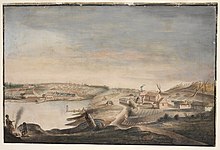
After Phillip's departure in December 1792, the colony's military officers began acquiring land and importing consumer goods from visiting ships. Former convicts engaged in trade and opened small businesses. Soldiers and former convicts built houses on Crown land, with or without official permission, in what was now commonly called Sydney town. Governor William Bligh (1806–08) imposed restrictions on commerce and ordered the demolition of buildings erected on Crown land, including some owned by past and serving military officers. The resulting conflict culminated in the Rum Rebellion of 1808, in which Bligh was deposed by the New South Wales Corps.[56][57]
Governor Lachlan Macquarie (1810–1821) played a leading role in the development of Sydney and New South Wales, establishing a bank, a currency and a hospital. He employed a planner to design the street layout of Sydney and commissioned the construction of roads, wharves, churches, and public buildings. Parramatta Road, linking Sydney and Parramatta, was opened in 1811,[58] and a road across the Blue Mountains was completed in 1815, opening the way for large-scale farming and grazing west of the Great Dividing Range.[59][60]
Following the departure of Macquarie, official policy encouraged the emigration of free British settlers to New South Wales. Immigration to the colony increased from 900 free settlers in 1826–30 to 29,000 in 1836–40, many of whom settled in Sydney.[61][62] By the 1840s Sydney exhibited a geographic divide between poor and working-class residents living west of the Tank Stream in areas such as The Rocks, and the more affluent residents living to its east.[62] Free settlers, free-born residents and former convicts now represented the vast majority of the population of Sydney, leading to increasing public agitation for responsible government and an end to transportation. Transportation to New South Wales ceased in 1840.[63]

In 1804, Irish convicts led around 300 rebels in the Castle Hill Rebellion, an attempt to march on Sydney, commandeer a ship, and sail to freedom.[64] Poorly armed, and with their leader Philip Cunningham captured, the main body of insurgents were routed by about 100 troops and volunteers at Rouse Hill. At least 39 convicts were killed in the uprising and subsequent executions.[65][66]
As the colony spread to the more fertile lands around the Hawkesbury River, north-west of Sydney, conflict between the settlers and the Darug people intensified, reaching a peak from 1794 to 1810. Bands of Darug people, led by Pemulwuy and later by his son Tedbury, burned crops, killed livestock and raided settler stores in a pattern of resistance that was to be repeated as the colonial frontier expanded. A military garrison was established on the Hawkesbury in 1795. The death toll from 1794 to 1800 was 26 settlers and up to 200 Darug.[67][68]
Conflict again erupted from 1814 to 1816 with the expansion of the colony into Dharawal country in the Nepean region south-west of Sydney. Following the deaths of several settlers, Governor Macquarie dispatched three military detachments into Dharawal lands, culminating in the Appin massacre (April 1816) in which at least 14 Aboriginal people were killed.[69][70]
The New South Wales Legislative Council became a semi-elected body in 1842. Sydney was declared a city the same year, and a governing council established, elected on a restrictive property franchise.[63]

The discovery of gold in New South Wales and Victoria in 1851 initially caused economic disruption as men moved to the goldfields. Melbourne soon overtook Sydney as Australia's largest city, leading to an enduring rivalry between the two. However, increased immigration from overseas and wealth from gold exports increased demand for housing, consumer goods, services and urban amenities.[71] The New South Wales government also stimulated growth by investing heavily in railways, trams, roads, ports, telegraph, schools and urban services.[72] The population of Sydney and its suburbs grew from 95,600 in 1861 to 386,900 in 1891.[73] The city developed many of its characteristic features. The growing population packed into rows of terrace houses in narrow streets. New public buildings of sandstone abounded, including at the University of Sydney (1854–61),[74] the Australian Museum (1858–66),[75] the Town Hall (1868–88),[76] and the General Post Office (1866–92).[77] Elaborate coffee palaces and hotels were erected.[78] Daylight bathing at Sydney's beaches was banned, but segregated bathing at designated ocean baths was popular.[79]
Drought, the winding down of public works and a financial crisis led to economic depression in Sydney throughout most of the 1890s. Meanwhile, the Sydney-based premier of New South Wales, George Reid, became a key figure in the process of federation.[80]
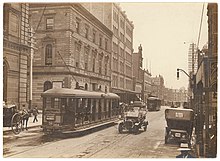
When the six colonies federated on 1 January 1901, Sydney became the capital of the State of New South Wales. The spread of bubonic plague in 1900 prompted the state government to modernise the wharves and demolish inner-city slums. The outbreak of the First World War in 1914 saw more Sydney males volunteer for the armed forces than the Commonwealth authorities could process, and helped reduce unemployment. Those returning from the war in 1918 were promised "homes fit for heroes" in new suburbs such as Daceyville and Matraville. "Garden suburbs" and mixed industrial and residential developments also grew along the rail and tram corridors.[62] The population reached one million in 1926, after Sydney had regained its position as the most populous city in Australia.[81] The government created jobs with massive public projects such as the electrification of the Sydney rail network and building the Sydney Harbour Bridge.[82]
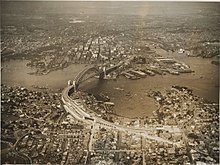
Sydney was more severely affected by the Great Depression of the 1930s than regional New South Wales or Melbourne.[83] New building almost came to a standstill, and by 1933 the unemployment rate for male workers was 28 per cent, but over 40 per cent in working class areas such as Alexandria and Redfern. Many families were evicted from their homes and shanty towns grew along coastal Sydney and Botany Bay, the largest being "Happy Valley" at La Perouse.[84] The Depression also exacerbated political divisions. In March 1932, when populist Labor premier Jack Lang attempted to open the Sydney Harbour Bridge he was upstaged by Francis de Groot of the far-right New Guard, who slashed the ribbon with a sabre.[85]
In January 1938, Sydney celebrated the Empire Games and the sesquicentenary of European settlement in Australia. One journalist wrote, "Golden beaches. Sun tanned men and maidens...Red-roofed villas terraced above the blue waters of the harbour...Even Melbourne seems like some grey and stately city of Northern Europe compared with Sydney's sub-tropical splendours." A congress of the "Aborigines of Australia" declared 26 January "A Day of Mourning" for "the whiteman's seizure of our country."[86]
With the outbreak of Second World War in 1939, Sydney experienced a surge in industrial development. Unemployment virtually disappeared and women moved into jobs previously typically reserved for males. Sydney was attacked by Japanese submarines in May and June 1942 with 21 killed. Households built air raid shelters and performed drills.[87] Military establishments in response to World War II in Australia included the Garden Island Tunnel System, the only tunnel warfare complex in Sydney, and the heritage-listed military fortification systems Bradleys Head Fortification Complex and Middle Head Fortifications, which were part of a total defence system for Sydney Harbour.[88]
A post-war immigration and baby boom saw a rapid increase in Sydney's population and the spread of low-density housing in suburbs throughout the Cumberland Plain. Immigrants—mostly from Britain and continental Europe—and their children accounted for over three-quarters of Sydney's population growth between 1947 and 1971.[89] The newly created Cumberland County Council oversaw low-density residential developments, the largest at Green Valley and Mount Druitt. Older residential centres such as Parramatta, Bankstown and Liverpool became suburbs of the metropolis.[90] Manufacturing, protected by high tariffs, employed over a third of the workforce from 1945 to the 1960s. However, as the long post-war economic boom progressed, retail and other service industries became the main source of new jobs.[91]
An estimated one million onlookers, most of the city's population, watched Queen Elizabeth II land in 1954 at Farm Cove where Captain Phillip had raised the Union Jack 165 years earlier, commencing her Australian Royal Tour. It was the first time a reigning monarch stepped onto Australian soil.[92]
Increasing high-rise development in Sydney and the expansion of suburbs beyond the "green belt" envisaged by the planners of the 1950s resulted in community protests. In the early 1970s, trade unions and resident action groups imposed green bans on development projects in historic areas such as The Rocks. Federal, State and local governments introduced heritage and environmental legislation.[62] The Sydney Opera House was also controversial for its cost and disputes between architect Jørn Utzon and government officials. However, soon after it opened in 1973 it became a major tourist attraction and symbol of the city.[93] The progressive reduction in tariff protection from 1974 began the transformation of Sydney from a manufacturing centre to a "world city".[94] From the 1980s, overseas immigration grew rapidly, with Asia, the Middle East and Africa becoming major sources. By 2021, the population of Sydney was over 5.2 million, with 40% of the population born overseas. China and India overtook England as the largest source countries for overseas-born residents.[95]
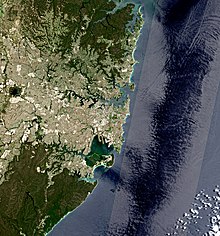
Sydney is a coastal basin with the Tasman Sea to the east, the Blue Mountains to the west, the Hawkesbury River to the north, and the Woronora Plateau to the south.
Sydney spans two geographic regions. The Cumberland Plain lies to the south and west of the Harbour and is relatively flat. The Hornsby Plateau is located to the north and is dissected by steep valleys. The flat areas of the south were the first to be developed; it was not until the construction of the Sydney Harbour Bridge that the northern reaches became more heavily populated. Seventy surf beaches can be found along its coastline, with Bondi Beach being the most famous.
The Nepean River wraps around the western edge of the city and becomes the Hawkesbury River before reaching Broken Bay. Most of Sydney's water storages can be found on tributaries of the Nepean River. The Parramatta River is mostly industrial and drains a large area of Sydney's western suburbs into Port Jackson. The southern parts of the city are drained by the Georges River and the Cooks River into Botany Bay.
There is no single definition of the boundaries of Sydney. The Australian Statistical Geography Standard definition of Greater Sydney covers 12,369 km2 (4,776 sq mi) and includes the local government areas of Central Coast in the north, Hawkesbury in the north-west, Blue Mountains in the west, Sutherland Shire in the south, and Wollondilly in the south-west.[96] The local government area of the City of Sydney covers about 26 square kilometres from Garden island in the east to Bicentennial Park in the west, and south to the suburbs of Alexandria and Rosebery.[97]

Sydney is made up of mostly Triassic rock with some recent igneous dykes and volcanic necks (typically found in the Prospect dolerite intrusion, west of Sydney).[98] The Sydney Basin was formed in the early Triassic period.[99] The sand that was to become the sandstone of today was laid down between 360 and 200 million years ago. The sandstone has shale lenses and fossil riverbeds.[99] The continental shelf of Australia is only 25.9 km (16.1 mi) away from the coast of Sydney, and that is where the Tasman Abyssal Plain lies.[100][101]
The Sydney Basin bioregion includes coastal features of cliffs, beaches, and estuaries. Deep river valleys known as rias were carved during the Triassic period in the Hawkesbury sandstone of the coastal region. The rising sea level between 18,000 and 6,000 years ago flooded the rias to form estuaries and deep harbours.[99] Port Jackson, better known as Sydney Harbour, is one such ria.[102] Sydney features two major soil types: sandy soils (which originate from the Hawkesbury sandstone) and clay (which are from shales and volcanic rocks), though some soils may be a mixture of the two.[103]
Directly overlying the older Hawkesbury sandstone is the Wianamatta shale, a geological feature found in western Sydney that was deposited in connection with a large river delta during the Middle Triassic. The Wianamatta shale generally comprises fine grained sedimentary rocks such as shales, mudstones, ironstones, siltstones and laminites, with less common sandstone units.[104] The Wianamatta Group is made up of Bringelly Shale, Minchinbury Sandstone and Ashfield Shale.[105]

The most prevalent plant communities in the Sydney region are grassy woodlands (i.e. savannas)[106] and some pockets of dry sclerophyll forests,[107] which consist of eucalyptus trees, casuarinas, melaleucas, corymbias and angophoras, with shrubs (typically wattles, callistemons, grevilleas and banksias), and a semi-continuous grass in the understory.[108] The plants in this community tend to have rough, spiky leaves due to low soil fertility. Sydney also features a few areas of wet sclerophyll forests in the wetter, elevated areas in the north and northeast. These forests are defined by straight, tall tree canopies with a moist understory of soft-leaved shrubs, tree ferns and herbs.[109]
The predominant vegetation community in Sydney is the Cumberland Plain Woodland in Western Sydney (Cumberland Plain),[110] followed by the Sydney Turpentine-Ironbark Forest in the Inner West and Northern Sydney,[111] the Eastern Suburbs Banksia Scrub in the coastline and the Blue Gum High Forest scantily present in the North Shore – all of which are critically endangered.[112][113] The city also includes the Sydney Sandstone Ridgetop Woodland found in Ku-ring-gai Chase National Park on the Hornsby Plateau to the north.[114]
Sydney is home to dozens of bird species,[115] which commonly include the Australian raven, Australian magpie, crested pigeon, noisy miner and the pied currawong. Introduced bird species ubiquitously found in Sydney are the common myna, common starling, house sparrow and the spotted dove.[116] Reptile species are also numerous and predominantly include skinks.[117][118] Sydney has a few mammal and spider species, such as the grey-headed flying fox and the Sydney funnel-web, respectively,[119][120] and has a huge diversity of marine species inhabiting its harbour and beaches.[121]

Under the Köppen–Geiger classification, Sydney has a humid subtropical climate (Cfa)[122] with "warm, sometimes hot" summers and "generally mild",[123][124][125] to "cool" winters.[126] The El Niño–Southern Oscillation, the Indian Ocean Dipole and the Southern Annular Mode[127][128] play an important role in determining Sydney's weather patterns: drought and bushfire on the one hand, and storms and flooding on the other, associated with the opposite phases of the oscillation in Australia. The weather is moderated by proximity to the ocean, and more extreme temperatures are recorded in the inland western suburbs because Sydney CBD is more affected by the oceanic climate drivers than the western suburbs.[129][130]
At Sydney's primary weather station at Observatory Hill, extreme temperatures have ranged from 45.8 °C (114.4 °F) on 18 January 2013 to 2.1 °C (35.8 °F) on 22 June 1932.[131][132][133] An average of 14.9 days a year have temperatures at or above 30 °C (86 °F) in the central business district (CBD).[130] In contrast, the metropolitan area averages between 35 and 65 days, depending on the suburb.[134] The hottest day in the metropolitan area occurred in Penrith on 4 January 2020, where a high of 48.9 °C (120.0 °F) was recorded.[135] The average annual temperature of the sea ranges from 18.5 °C (65.3 °F) in September to 23.7 °C (74.7 °F) in February.[136] Sydney has an average of 7.2 hours of sunshine per day[137] and 109.5 clear days annually.[4] Due to the inland location, frost is recorded early in the morning in Western Sydney a few times in winter. Autumn and spring are the transitional seasons, with spring showing a larger temperature variation than autumn.[138]
Sydney experiences an urban heat island effect.[139] This makes certain parts of the city more vulnerable to extreme heat, including coastal suburbs.[139][140] In late spring and summer, temperatures over 35 °C (95 °F) are not uncommon,[141] though hot, dry conditions are usually ended by a southerly buster,[142] a powerful southerly that brings gale winds and a rapid fall in temperature.[143] Since Sydney is downwind of the Great Dividing Range, it occasionally experiences dry, westerly foehn winds typically in winter and early spring (which are the reason for its warm maximum temperatures).[144][145][146] Westerly winds are intense when the Roaring Forties (or the Southern Annular Mode) shift towards southeastern Australia,[147] where they may damage homes and affect flights, in addition to making the temperature seem colder than it actually is.[148][149]
Rainfall has a moderate to low variability and has historically been fairly uniform throughout the year, although in recent years it has been more summer-dominant and erratic.[150][151][152][153] Precipitation is usually higher in summer through to autumn,[124] and lower in late winter to early spring.[127][154][130][155] In late autumn and winter, east coast lows may bring large amounts of rainfall, especially in the CBD.[156] In the warm season black nor'easters are usually the cause of heavy rain events, though other forms of low-pressure areas, including remnants of ex-cyclones, may also bring heavy deluge and afternoon thunderstorms.[157][158] 'Snow' was last alleged in 1836, more than likely a fall of graupel, or soft hail; and in July 2008 the Upper North Shore saw a fall of graupel that was mistaken by many for 'snow'.[159] In 2009, dry conditions brought a severe dust storm towards the city.[160][161]
| Month | Jan | Feb | Mar | Apr | May | Jun | Jul | Aug | Sep | Oct | Nov | Dec | Year |
|---|---|---|---|---|---|---|---|---|---|---|---|---|---|
| Record high °C (°F) | 45.8 (114.4) |
42.1 (107.8) |
39.8 (103.6) |
35.4 (95.7) |
30.0 (86.0) |
26.9 (80.4) |
26.5 (79.7) |
31.3 (88.3) |
34.6 (94.3) |
38.2 (100.8) |
41.8 (107.2) |
42.2 (108.0) |
45.8 (114.4) |
| Mean maximum °C (°F) | 36.8 (98.2) |
34.1 (93.4) |
32.2 (90.0) |
29.7 (85.5) |
26.2 (79.2) |
22.3 (72.1) |
22.9 (73.2) |
25.4 (77.7) |
29.9 (85.8) |
33.6 (92.5) |
34.1 (93.4) |
34.4 (93.9) |
38.8 (101.8) |
| Mean daily maximum °C (°F) | 27.0 (80.6) |
26.8 (80.2) |
25.7 (78.3) |
23.6 (74.5) |
20.9 (69.6) |
18.3 (64.9) |
17.9 (64.2) |
19.3 (66.7) |
21.6 (70.9) |
23.2 (73.8) |
24.2 (75.6) |
25.7 (78.3) |
22.8 (73.0) |
| Daily mean °C (°F) | 23.5 (74.3) |
23.4 (74.1) |
22.1 (71.8) |
19.5 (67.1) |
16.6 (61.9) |
14.2 (57.6) |
13.4 (56.1) |
14.5 (58.1) |
17.0 (62.6) |
18.9 (66.0) |
20.4 (68.7) |
22.1 (71.8) |
18.8 (65.8) |
| Mean daily minimum °C (°F) | 20.0 (68.0) |
19.9 (67.8) |
18.4 (65.1) |
15.3 (59.5) |
12.3 (54.1) |
10.0 (50.0) |
8.9 (48.0) |
9.7 (49.5) |
12.3 (54.1) |
14.6 (58.3) |
16.6 (61.9) |
18.4 (65.1) |
14.7 (58.5) |
| Mean minimum °C (°F) | 16.1 (61.0) |
16.1 (61.0) |
14.2 (57.6) |
11.0 (51.8) |
8.3 (46.9) |
6.5 (43.7) |
5.7 (42.3) |
6.1 (43.0) |
8.0 (46.4) |
9.8 (49.6) |
12.0 (53.6) |
13.9 (57.0) |
5.3 (41.5) |
| Record low °C (°F) | 10.6 (51.1) |
9.6 (49.3) |
9.3 (48.7) |
7.0 (44.6) |
4.4 (39.9) |
2.1 (35.8) |
2.2 (36.0) |
2.7 (36.9) |
4.9 (40.8) |
5.7 (42.3) |
7.7 (45.9) |
9.1 (48.4) |
2.1 (35.8) |
| Average rainfall mm (inches) | 91.1 (3.59) |
131.5 (5.18) |
117.5 (4.63) |
114.1 (4.49) |
100.8 (3.97) |
142.0 (5.59) |
80.3 (3.16) |
75.1 (2.96) |
63.4 (2.50) |
67.7 (2.67) |
90.6 (3.57) |
73.0 (2.87) |
1,149.7 (45.26) |
| Average rainy days (≥ 1 mm) | 8.2 | 9.0 | 10.1 | 7.9 | 7.9 | 9.3 | 7.2 | 5.6 | 5.8 | 7.6 | 8.7 | 7.9 | 95.2 |
| Average afternoon relative humidity (%) | 60 | 62 | 59 | 58 | 58 | 56 | 52 | 47 | 49 | 53 | 57 | 58 | 56 |
| Average dew point °C (°F) | 16.5 (61.7) |
17.2 (63.0) |
15.4 (59.7) |
12.7 (54.9) |
10.3 (50.5) |
7.8 (46.0) |
6.1 (43.0) |
5.4 (41.7) |
7.8 (46.0) |
10.2 (50.4) |
12.6 (54.7) |
14.6 (58.3) |
11.4 (52.5) |
| Mean monthly sunshine hours | 232.5 | 205.9 | 210.8 | 213.0 | 204.6 | 171.0 | 207.7 | 248.0 | 243.0 | 244.9 | 222.0 | 235.6 | 2,639 |
| Percentage possible sunshine | 53 | 54 | 55 | 63 | 63 | 57 | 66 | 72 | 67 | 61 | 55 | 55 | 60 |
| Source 1: Bureau of Meteorology[162][163][164][165] | |||||||||||||
| Source 2: Bureau of Meteorology, Sydney Airport (sunshine hours)[166] | |||||||||||||
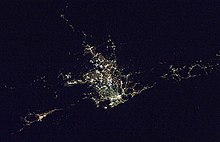
The Greater Sydney Commission divides Sydney into three "cities" and five "districts" based on the 33 LGAs in the metropolitan area. The "metropolis of three cities" comprises Eastern Harbour City, Central River City and Western Parkland City.[167] The Australian Bureau of Statistics also includes City of Central Coast (the former Gosford City and Wyong Shire) as part of Greater Sydney for population counts,[168] adding 330,000 people.[169]
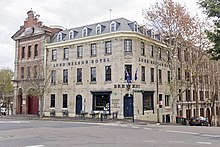
The CBD extends about 3 km (1.9 mi) south from Sydney Cove. It is bordered by Farm Cove within the Royal Botanic Garden to the east and Darling Harbour to the west. Suburbs surrounding the CBD include Woolloomooloo and Potts Point to the east, Surry Hills and Darlinghurst to the south, Pyrmont and Ultimo to the west, and Millers Point and The Rocks to the north. Most of these suburbs measure less than 1 km2 (0.4 sq mi) in area. The Sydney CBD is characterised by narrow streets and thoroughfares, created in its convict beginnings.[170]
Several localities, distinct from suburbs, exist throughout Sydney's inner reaches. Central and Circular Quay are transport hubs with ferry, rail, and bus interchanges. Chinatown, Darling Harbour, and Kings Cross are important locations for culture, tourism, and recreation. The Strand Arcade, located between Pitt Street Mall and George Street, is a historical Victorian-style shopping arcade. Opened on 1 April 1892, its shop fronts are an exact replica of the original internal shopping facades.[171] Westfield Sydney, located beneath the Sydney Tower, is the largest shopping centre by area in Sydney.[172]
Since the late 20th century, there has been a trend of gentrification amongst Sydney's inner suburbs. Pyrmont, located on the harbour, was redeveloped from a centre of shipping and international trade to an area of high density housing, tourist accommodation, and gambling.[173] Originally located well outside of the city, Darlinghurst is the location of the historic Darlinghurst Gaol, manufacturing, and mixed housing. For a period it was known as an area of prostitution. The terrace-style housing has largely been retained and Darlinghurst has undergone significant gentrification since the 1980s.[174][175][176]
Green Square is a former industrial area of Waterloo which is undergoing urban renewal worth $8 billion. On the city harbour edge, the historic suburb and wharves of Millers Point are being built up as the new area of Barangaroo.[177][178] The suburb of Paddington is known for its restored terrace houses, Victoria Barracks, and shopping including the weekly Oxford Street markets.[179]
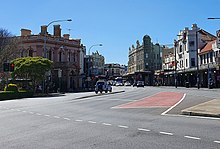
The Inner West generally includes the Inner West Council, Municipality of Burwood, Municipality of Strathfield, and City of Canada Bay. These span up to about 11 km west of the CBD. Historically, especially prior to the building of the Harbour Bridge,[180] the outer suburbs of the Inner West such as Strathfield were the location of "country" estates for the colony's elites. By contrast, the inner suburbs in the Inner West, being close to transport and industry, have historically housed working-class industrial workers. These areas have undergone gentrification in the late 20th century, and many parts are now highly valued residential suburbs.[181] As of 2021, an Inner West suburb (Strathfield) remained one of the 20 most expensive postcodes in Australia by median house price (the others were all in metropolitan Sydney, all in Northern Sydney or the Eastern Suburbs).[182] The University of Sydney is located in this area, as well as the University of Technology, Sydney and a campus of the Australian Catholic University. The Anzac Bridge spans Johnstons Bay and connects Rozelle to Pyrmont and the city, forming part of the Western Distributor.
The Inner West is today well known as the location of village commercial centres with cosmopolitan flavours, such as the "Little Italy" commercial centres of Leichardt, Five Dock and Haberfield,[183] "Little Portugal" in Petersham,[184] "Little Korea" in Strathfield[185] or "Little Shanghai" in Ashfield.[186] Large-scale shopping centres in the area include Westfield Burwood, DFO Homebush and Birkenhead Point Outlet Centre. There is a large cosmopolitan community and nightlife hub on King Street, Newtown.
The area is serviced by Sydney Trains' T1, T2 and T3 services, including the Main Suburban Line, which was the first to be constructed in New South Wales. Strathfield railway station is a secondary railway hub within Sydney, and major station on the Suburban and Northern lines. It was constructed in 1876.[187] The future Sydney Metro West will also connect this area with the City and Parramatta. The area is also serviced by the Parramatta River services of Sydney Ferries,[188] numerous bus routes and cycleways.[189]

The Eastern Suburbs encompass the Municipality of Woollahra, the City of Randwick, the Waverley Municipal Council, and parts of the Bayside Council. They include some of the most affluent and advantaged areas in the country, with some streets being amongst the most expensive in the world. As at 2014, Wolseley Road, Point Piper, had a top price of $20,900 per square metre, making it the ninth-most expensive street in the world.[191] More than 75% of neighbourhoods in the Electoral District of Wentworth fall under the top decile of SEIFA advantage, making it the least disadvantaged area in the country.[192] As of 2021, of the 20 most expensive postcodes in Australia by median house price, nine were in the Eastern Suburbs.[182]
Major landmarks include Bondi Beach, which was added to the Australian National Heritage List in 2008;[193] and Bondi Junction, featuring a Westfield shopping centre and an estimated office workforce of 6,400 by 2035,[194] as well as a railway station on the T4 Eastern Suburbs Line. The suburb of Randwick contains Randwick Racecourse, the Royal Hospital for Women, the Prince of Wales Hospital, Sydney Children's Hospital, and University of New South Wales Kensington Campus.[195]
Construction of the CBD and South East Light Rail was completed in April 2020.[196] The project aims to provide reliable and high-capacity tram services to residents in the City and South-East.
Major shopping centres in the area include Westfield Bondi Junction and Westfield Eastgardens.

The Southern district of Sydney includes the suburbs in the local government areas of the Georges River Council (collectively known as St George) and the Sutherland Shire (colloquially known as 'The Shire'), on the southern banks of the Georges River.
The Kurnell peninsula, near Botany Bay, is the site of the first landfall on the eastern coastline made by James Cook in 1770. La Perouse, a historic suburb named after the French navigator Jean-François de Galaup, comte de Lapérouse, is notable for its old military outpost at Bare Island and the Botany Bay National Park.
The suburb of Cronulla in southern Sydney is close to Royal National Park, Australia's oldest national park. Hurstville, a large suburb with commercial and high-rise residential buildings dominating the skyline, has become a CBD for the southern suburbs.[197]
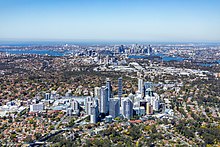
'Northern Sydney' includes the suburbs in the Upper North Shore, Lower North Shore and the Northern Beaches.
The Northern Suburbs include several landmarks – Macquarie University, Gladesville Bridge, Ryde Bridge, Macquarie Centre and Curzon Hall in Marsfield. This area includes suburbs in the local government areas of Hornsby Shire, Ku-ring-gai Council, City of Ryde, the Municipality of Hunter's Hill and parts of the City of Parramatta.
The North Shore includes the commercial centres of North Sydney and Chatswood. North Sydney itself consists of a large commercial centre, which contains the second largest concentration of high-rise buildings in Sydney after the CBD. North Sydney is dominated by advertising, marketing and associated trades, with many large corporations holding offices.
The Northern Beaches area includes Manly, one of Sydney's most popular holiday destinations. The region also features Sydney Heads, a series of headlands which form the entrance to Sydney Harbour. The Northern Beaches area extends south to the entrance of Port Jackson (Sydney Harbour), west to Middle Harbour and north to the entrance of Broken Bay.[198] The 2021 Australian census found the Northern Beaches to have, in comparison with the rest of Sydney, a large British diaspora and high concentration of people with European ancestry.[199]
As of the end of 2021, half of the 20 most expensive postcodes in Australia (by median house price) were in Northern Sydney, including four on the Northern Beaches, two on the Lower North Shore, three on the Upper North Shore, and one straddling Hunters Hill and Woolwich.[182]
The Hills district generally refers to the suburbs in north-western Sydney including the local government areas of The Hills Shire, parts of the City of Parramatta Council and Hornsby Shire. Actual suburbs and localities that are considered to be in the Hills District can be somewhat amorphous. For example, the Hills District Historical Society restricts its definition to the Hills Shire local government area, yet its study area extends from Parramatta to the Hawkesbury. The region is so named for its characteristically comparatively hilly topography as the Cumberland Plain lifts up, joining the Hornsby Plateau. Windsor and Old Windsor Roads are the second and third roads, respectively, laid in Australia.[200]
On 26 May 2019, The Sydney Metro Northwest, which went from Chatswood to Tallawong, opened, with a large portion running through the Hills District, which meant the Hills District, for the first time, started having heavy rail.[201] Before this, The Hills was served by Bus Rapid Transit.
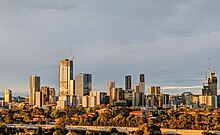
The greater western suburbs encompasses the areas of Parramatta, the sixth largest business district in Australia, settled the same year as the harbour-side colony,[202] Bankstown, Liverpool, Penrith, and Fairfield. Covering 5,800 km2 (2,200 sq mi) and having an estimated population as at 2017 of 2,288,554, western Sydney has the most multicultural suburbs in the country – Cabramatta has earned the nickname "Little Saigon" due to its Vietnamese population, Fairfield has been named "Little Assyria" for its predominant Assyrian population and Harris Park is known as "Little India" with its plurality of Indian and Hindu population.[203][204][205][206] The population is predominantly of a working class background, with major employment in the heavy industries and vocational trade.[207] Toongabbie is noted for being the third mainland settlement (after Sydney and Parramatta) set up after British colonisation began in 1788, although the site of the settlement is actually in the separate suburb of Old Toongabbie.[208]
The western suburb of Prospect, in the City of Blacktown, is home to Raging Waters, a water park operated by Parques Reunidos.[209] Auburn Botanic Gardens, a botanical garden in Auburn, attracts thousands of visitors each year, including many from outside Australia.[210] The greater west also includes Sydney Olympic Park, a suburb created to host the 2000 Summer Olympics, and Sydney Motorsport Park, a circuit in Eastern Creek.[211] Prospect Hill, a historically significant ridge in the west and the only area in Sydney with ancient volcanic activity,[212] is also listed on the State Heritage Register.[213]
To the northwest, Featherdale Wildlife Park, a zoo in Doonside, near Blacktown, is a major tourist attraction.[214] Sydney Zoo, opened in 2019, is another prominent zoo situated in Bungaribee.[215] Established in 1799, the Old Government House, a historic house museum and tourist spot in Parramatta, was included in the Australian National Heritage List on 1 August 2007 and World Heritage List in 2010 (as part of the 11 penal sites constituting the Australian Convict Sites), making it the only site in greater western Sydney to be featured in such lists.[216] The house is Australia's oldest surviving public building.[217]
Further to the southwest is the region of Macarthur and the city of Campbelltown, a significant population centre until the 1990s considered a region separate to Sydney proper. Macarthur Square, a shopping complex in Campbelltown, has become one of the largest shopping complexes in Sydney.[218] The southwest also features Bankstown Reservoir, the oldest elevated reservoir constructed in reinforced concrete that is still in use and is listed on the State Heritage Register.[219] The southwest is home to one of Sydney's oldest trees, the Bland Oak, which was planted in the 1840s by William Bland in Carramar.[220]
The earliest structures in the colony were built to the bare minimum of standards. Governor Macquarie set ambitious targets for the design of new construction projects. The city now has a world heritage listed building, several national heritage listed buildings, and dozens of Commonwealth heritage listed buildings as evidence of the survival of Macquarie's ideals.[222][223][224]
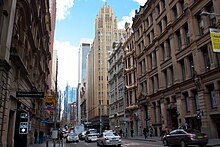
In 1814, the Governor called on a convict named Francis Greenway to design Macquarie Lighthouse.[225] The lighthouse's Classical design earned Greenway a pardon from Macquarie in 1818 and introduced a culture of refined architecture that remains to this day.[226] Greenway went on to design the Hyde Park Barracks in 1819 and the Georgian style St James's Church in 1824.[227][228] Gothic-inspired architecture became more popular from the 1830s. John Verge's Elizabeth Bay House and St Philip's Church of 1856 were built in Gothic Revival style along with Edward Blore's Government House of 1845.[229][230] Kirribilli House, completed in 1858, and St Andrew's Cathedral, Australia's oldest cathedral,[231] are rare examples of Victorian Gothic construction.[229][232]

From the late 1850s there was a shift towards Classical architecture. Mortimer Lewis designed the Australian Museum in 1857.[233] The General Post Office, completed in 1891 in Victorian Free Classical style, was designed by James Barnet.[234] Barnet also oversaw the 1883 reconstruction of Greenway's Macquarie Lighthouse.[225][226] Customs House was built in 1844.[235] The neo-Classical and French Second Empire style Town Hall was completed in 1889.[236][237] Romanesque designs gained favour from the early 1890s. Sydney Technical College was completed in 1893 using both Romanesque Revival and Queen Anne approaches.[238] The Queen Victoria Building was designed in Romanesque Revival fashion by George McRae; completed in 1898,[239] it accommodates 200 shops across its three storeys.[240]
As the wealth of the settlement increased and Sydney developed into a metropolis after Federation in 1901, its buildings became taller. Sydney's first tower was Culwulla Chambers which topped out at 50 m (160 ft) making 12 floors. The Commercial Traveller's Club, built in 1908, was of similar height at 10 floors. It was built in a brick stone veneer and demolished in 1972.[241] This heralded a change in Sydney's cityscape and with the lifting of height restrictions in the 1960s there came a surge of high-rise construction.[242]
The Great Depression had a tangible influence on Sydney's architecture. New structures became more restrained with far less ornamentation. The most notable architectural feat of this period is the Harbour Bridge. Its steel arch was designed by John Bradfield and completed in 1932. A total of 39,000 tonnes of structural steel span the 503 m (1,650 ft) between Milsons Point and Dawes Point.[243][244]

Modern and International architecture came to Sydney from the 1940s. Since its completion in 1973 the city's Opera House has become a World Heritage Site and one of the world's most renowned pieces of Modern design. Jørn Utzon was awarded the Pritzker Prize in 2003 for his work on the Opera House.[245] Sydney is home to Australia's first building by renowned Canadian-American architect Frank Gehry, the Dr Chau Chak Wing Building (2015). An entrance from The Goods Line–a pedestrian pathway and former railway line–is located on the eastern border of the site.
Contemporary buildings in the CBD include Citigroup Centre,[246] Aurora Place,[247] Chifley Tower,[248][249] the Reserve Bank building,[250] Deutsche Bank Place,[251] MLC Centre,[252] and Capita Centre.[253] The tallest structure is Sydney Tower, designed by Donald Crone and completed in 1981.[254] Due to the proximity of Sydney Airport, a maximum height restriction was imposed, now sitting at 330 metres (1083 feet).[255] Green bans and heritage overlays have been in place since at least 1977 to protect Sydney's heritage after controversial demolitions in the 1970s.[256]

Sydney surpasses both New York City and Paris real estate prices, having some of the most expensive in the world.[257][258] The city remains Australia's most expensive housing market, with the median house price at $1,595,310 as of December 2023[259]
There were 1.83 million dwellings in Sydney in 2021 including 900,000 (54%) detached houses, 218,000 (13%) semi-detached terrace houses and 550,000 (33%) units and apartments.[260] Whilst terrace houses are common in the inner city areas, detached houses dominate the landscape in the outer suburbs. Due to environmental and economic pressures, there has been a noted trend towards denser housing, with a 30% increase in the number of apartments between 1996 and 2006.[261] Public housing in Sydney is managed by the Government of New South Wales.[262] Suburbs with large concentrations of public housing include Claymore, Macquarie Fields, Waterloo, and Mount Druitt.
A range of heritage housing styles can be found throughout Sydney. Terrace houses are found in the inner suburbs such as Paddington, The Rocks, Potts Point and Balmain, many of which have been the subject of gentrification.[263][264] These terraces, particularly those in suburbs such as The Rocks, were historically home to Sydney's miners and labourers. In the present day, terrace houses now make up some of the most valuable real estate in the city.[265] Surviving large mansions from the Victorian era are mostly found in the oldest suburbs, such as Double Bay, Darling Point, Rose Bay and Strathfield.[266]
Federation homes, constructed around the time of Federation in 1901, are located in a large number of suburbs that developed thanks to the arrival of railways in the late 19th century, such as Penshurst and Turramurra, and in large-scale planned "garden suburbs" such as Haberfield. Workers cottages are found in Surry Hills, Redfern, and Balmain. California bungalows are common in Ashfield, Concord, and Beecroft. Larger modern homes are predominantly found in the outer suburbs, such as Stanhope Gardens, Kellyville Ridge, Bella Vista to the northwest, Bossley Park, Abbotsbury, and Cecil Hills to the west, and Hoxton Park, Harrington Park, and Oran Park to the southwest.[267]
The Anzac War Memorial in Hyde Park is a public memorial dedicated to the Australian Imperial Force of World War I.
The Royal Botanic Garden is the most iconic green space in the region, hosting both scientific and leisure activities.[268] There are 15 separate parks under the City administration.[269] Parks within the city centre include Hyde Park, The Domain and Prince Alfred Park.

The Centennial Parklands is the largest park in the City of Sydney, comprising 189 ha (470 acres).
The inner suburbs include Centennial Park and Moore Park in the east (both within the City of Sydney local government area), while the outer suburbs contain Sydney Park and Royal National Park in the south, Ku-ring-gai Chase National Park in the north, and Western Sydney Parklands in the west, which is one of the largest urban parks in the world. The Royal National Park was proclaimed in 1879 and with 13,200 ha (51 sq mi) is the second oldest national park in the world.[271]

Hyde Park is the oldest parkland in the country.[273] The largest park in the Sydney metropolitan area is Ku-ring-gai Chase National Park, established in 1894 with an area of 15,400 ha (59 sq mi).[274] It is regarded for its well-preserved records of indigenous habitation – more than 800 rock engravings, cave drawings and middens.[275]
The area now known as The Domain was set aside by Governor Arthur Phillip in 1788 as his private reserve.[276] Under the orders of Macquarie the land to the immediate north of The Domain became the Royal Botanic Garden in 1816. This makes them the oldest botanic garden in Australia.[276] The Gardens host scientific research with herbarium collections, a library and laboratories.[277] The two parks have a total area of 64 ha (0.2 sq mi) with 8,900 individual plant species and receive over 3.5 million annual visits.[278]
To the south of The Domain is Hyde Park, the oldest public parkland in Australia which measures 16.2 ha (0.1 sq mi).[279] Its location was used for both relaxation and grazing of animals from the earliest days of the colony.[280] Macquarie dedicated it in 1810 for the "recreation and amusement of the inhabitants of the town" and named it in honour of Hyde Park in London.
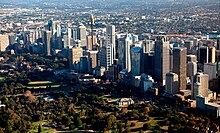
Researchers from Loughborough University have ranked Sydney amongst the top ten world cities that are highly integrated into the global economy.[282] The Global Economic Power Index ranks Sydney eleventh in the world.[283] The Global Cities Index recognises it as fourteenth in the world based on global engagement.[284] There is a significant concentration of foreign banks and multinational corporations in Sydney and the city is promoted as Australia's financial capital and one of Asia Pacific's leading financial hubs.[285][286]
The prevailing economic theory during early colonial days was mercantilism, as it was throughout most of Western Europe.[287] The economy struggled at first due to difficulties in cultivating the land and the lack of a stable monetary system. Governor Macquarie created two coins from every Spanish silver dollar in circulation.[287] The economy was capitalist in nature by the 1840s as the proportion of free settlers increased, the maritime and wool industries flourished, and the powers of the East India Company were curtailed.[287]
Wheat, gold, and other minerals became export industries towards the end of the 1800s.[287] Significant capital began to flow into the city from the 1870s to finance roads, railways, bridges, docks, courthouses, schools and hospitals. Protectionist policies after federation allowed for the creation of a manufacturing industry which became the city's largest employer by the 1920s.[287] These same policies helped to relieve the effects of the Great Depression during which the unemployment rate in New South Wales reached as high as 32%.[287] From the 1960s onwards Parramatta gained recognition as the city's second CBD and finance and tourism became major industries and sources of employment.[287]
Sydney's nominal gross domestic product was AU$400.9 billion and AU$80,000 per capita[288] in 2015.[289][286] Its gross domestic product was AU$337 billion in 2013, the largest in Australia.[289] The financial and insurance services industry accounts for 18.1% of gross product, ahead of professional services with 9% and manufacturing with 7.2%. The creative and technology sectors are also focus industries for the City of Sydney and represented 9% and 11% of its economic output in 2012.[290][291]
There were 451,000 businesses based in Sydney in 2011, including 48% of the top 500 companies in Australia and two-thirds of the regional headquarters of multinational corporations.[292] Global companies are attracted to the city in part because its time zone spans the closing of business in North America and the opening of business in Europe. Most foreign companies in Sydney maintain significant sales and service functions but comparably less production, research, and development capabilities.[293] There are 283 multinational companies with regional offices in Sydney.[294]
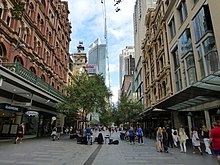
Sydney has been ranked between the fifteenth and the fifth most expensive city in the world and is the most expensive city in Australia.[296] Of the 15 categories only measured by UBS in 2012, workers receive the seventh highest wage levels of 77 cities in the world.[296] Working residents of Sydney work an average of 1,846 hours per annum with 15 days of leave.[296]
The labour force of Greater Sydney Region in 2016 was 2,272,722 with a participation rate of 61.6%.[297] It comprised 61.2% full-time workers, 30.9% part-time workers, and 6.0% unemployed individuals.[260][298] The largest reported occupations are professionals, clerical and administrative workers, managers, technicians and trades workers, and community and personal service workers.[260] The largest industries by employment across Greater Sydney are Health Care and Social Assistance (11.6%), Professional Services (9.8%), Retail Trade (9.3%), Construction (8.2%), Education and Training (8.0%), Accommodation and Food Services (6.7%), and Financial and Insurance Services (6.6%).[2] The Professional Services and Financial and Insurance Services industries account for 25.4% of employment within the City of Sydney.[299]
In 2016, 57.6% of working-age residents had a weekly income of less than $1,000 and 14.4% had a weekly income of $1,750 or more.[300] The median weekly income for the same period was $719 for individuals, $1,988 for families, and $1,750 for households.[301]
Unemployment in the City of Sydney averaged 4.6% for the decade to 2013, much lower than the current rate of unemployment in Western Sydney of 7.3%.[286][302] Western Sydney continues to struggle to create jobs to meet its population growth despite the development of commercial centres like Parramatta. Each day about 200,000 commuters travel from Western Sydney to the CBD and suburbs in the east and north of the city.[302]
Home ownership in Sydney was less common than renting prior to the Second World War but this trend has since reversed.[261] Median house prices have increased by an average of 8.6% per annum since 1970.[303][304] The median house price in March 2014 was $630,000.[305] The primary cause of rising prices is the increasing cost of land and scarcity.[306] 31.6% of dwellings in Sydney are rented, 30.4% are owned outright and 34.8% are owned with a mortgage.[260] 11.8% of mortgagees in 2011 had monthly loan repayments of less than $1,000 and 82.9% had monthly repayments of $1,000 or more.[2] 44.9% of renters for the same period had weekly rent of less than $350 whilst 51.7% had weekly rent of $350 or more. The median weekly rent in Sydney in 2011 was $450.[2]

Macquarie gave a charter in 1817 to form the first bank in Australia, the Bank of New South Wales.[307] New private banks opened throughout the 1800s but the financial system was unstable. Bank collapses were frequent and a crisis point was reached in 1893 when 12 banks failed.[307]
The Bank of New South Wales exists to this day as Westpac.[308] The Commonwealth Bank of Australia was formed in Sydney in 1911 and began to issue notes backed by the resources of the nation. It was replaced in this role in 1959 by the Reserve Bank of Australia, also based in Sydney.[307] The Australian Securities Exchange began operating in 1987 and with a market capitalisation of $1.6 trillion is now one of the ten largest exchanges in the world.[309]
The Financial and Insurance Services industry now constitutes 43% of the economic product of the City of Sydney.[285] Sydney makes up half of Australia's finance sector and has been promoted by consecutive Commonwealth Governments as Asia Pacific's leading financial centre.[20][21][310] In the 2017 Global Financial Centres Index, Sydney was ranked as having the eighth most competitive financial centre in the world.[311]
In 1985 the Federal Government granted 16 banking licences to foreign banks and now 40 of the 43 foreign banks operating in Australia are based in Sydney, including the People's Bank of China, Bank of America, Citigroup, UBS, Mizuho Bank, Bank of China, Banco Santander, Credit Suisse, Standard Chartered, State Street, HSBC, Deutsche Bank, Barclays, Royal Bank of Canada, Société Générale, Royal Bank of Scotland, Sumitomo Mitsui, ING Group, BNP Paribas, and Investec.[285][307][312][313]
Sydney has been a manufacturing city since the 1920s. By 1961 the industry accounted for 39% of all employment and by 1970 over 30% of all Australian manufacturing jobs were in Sydney.[314] Its status has declined in recent decades, making up 12.6% of employment in 2001 and 8.5% in 2011.[2][314] Between 1970 and 1985 there was a loss of 180,000 manufacturing jobs.[314] Despite this, Sydney still overtook Melbourne as the largest manufacturing centre in Australia in the 2010s,[315] with a manufacturing output of $21.7 billion in 2013.[316] Observers have credited Sydney's focus on the domestic market and high-tech manufacturing for its resilience against the high Australian dollar of the early 2010s.[316] The Smithfield-Wetherill Park Industrial Estate in Western Sydney is the largest industrial estate in the Southern Hemisphere and is the centre of manufacturing and distribution in the region.[317]

Sydney is a gateway to Australia for many international visitors and ranks among the top sixty most visited cities in the world.[318] It has hosted over 2.8 million international visitors in 2013, or nearly half of all international visits to Australia. These visitors spent 59 million nights in the city and a total of $5.9 billion.[24] The countries of origin in descending order were China, New Zealand, the United Kingdom, the United States, South Korea, Japan, Singapore, Germany, Hong Kong, and India.[319]
The city also received 8.3 million domestic overnight visitors in 2013 who spent a total of $6 billion.[319] 26,700 workers in the City of Sydney were directly employed by tourism in 2011.[320] There were 480,000 visitors and 27,500 people staying overnight each day in 2012.[320] On average, the tourism industry contributes $36 million to the city's economy per day.[320]
Popular destinations include the Sydney Opera House, the Sydney Harbour Bridge, Watsons Bay, The Rocks, Sydney Tower, Darling Harbour, the Royal Botanic Garden, the Australian Museum, the Museum of Contemporary Art, the Art Gallery of New South Wales, the Queen Victoria Building, Sea Life Sydney Aquarium, Taronga Zoo, Bondi Beach, Luna Park and Sydney Olympic Park.[321]
Major developmental projects designed to increase Sydney's tourism sector include a casino and hotel at Barangaroo and the redevelopment of East Darling Harbour, which involves a new exhibition and convention centre, now Australia's largest.[322][323][324]
Sydney is the highest-ranking city in the world for international students. More than 50,000 international students study at the city's universities and a further 50,000 study at its vocational and English language schools.[284][325] International education contributes $1.6 billion to the local economy and creates demand for 4,000 local jobs each year.[326]
In 2023, Sydney was ranked the least affordable city to buy a house in Australia and the second least affordable city in the world, after Hong Kong,[327] with the average Sydney house price in late 2023 costing A$1.59 million, and the average unit price costing A$795,000.[328] As of early 2024, Sydney is often described in the media as having a housing shortage, or suffering a housing crisis.[329][330]

The population of Sydney in 1788 was less than 1,000.[332] With convict transportation it almost tripled in ten years to 2,953.[333] For each decade since 1961 the population has increased by more than 250,000.[334] The 2021 census recorded the population of Greater Sydney as 5,231,150.[1] The Australian Treasury expects the population will grow to 6.5 million in 2033–34.[335] The four most densely populated suburbs in Australia are located in Sydney with each having more than 13,000 residents per square kilometre (33,700 residents per square mile).[336] Between 1971 and 2018, Sydney experienced a net loss of 716,832 people to the rest of Australia, but its population grew due to overseas arrivals and a healthy birth rate.[337]
The median age of Sydney residents is 37 and 14.8% of people are 65 or older.[260] 48.6% of Sydney's population is married whilst 36.7% have never been married.[260] 49.0% of families are couples with children, 34.4% are couples without children, and 14.8% are single-parent families.[260]
| Birthplace[N 1] | Population |
|---|---|
| Australia | 2,970,737 |
| Mainland China | 238,316 |
| India | 187,810 |
| England | 153,052 |
| Vietnam | 93,778 |
| Philippines | 91,339 |
| New Zealand | 85,493 |
| Lebanon | 61,620 |
| Nepal | 59,055 |
| Iraq | 52,604 |
| South Korea | 50,702 |
| Hong Kong SAR | 46,182 |
| South Africa | 39,564 |
| Italy | 38,762 |
| Indonesia | 35,413 |
| Malaysia | 35,002 |
| Fiji | 34,197 |
| Pakistan | 31,025 |
At the 2021 census, the most common ancestries were:[11]
At the 2021 census, 40.5% of Sydney's population was born overseas. Foreign countries of birth with the greatest representation are mainland China, India, England, Vietnam, Philippines and New Zealand.[11]
At the 2021 census, 1.7% of Sydney's population identified as being Indigenous — Aboriginal Australians and Torres Strait Islanders.[N 3][340]
42% of households in Sydney use a language other than English, with the most common being Mandarin (5%), Arabic (4.2%), Cantonese (2.8%), Vietnamese (2.2%) and Hindi (1.5%).[340]
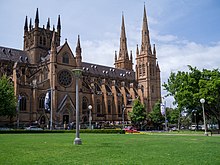
In 2021, Christianity was the largest religious affiliation at 46%, the largest denominations of which were Catholicism at 23.1% and Anglicanism at 9.2%. 30.3% of Sydney residents identified as having no religion. The most common non-Christian religious affiliations were Islam (6.3%), Hinduism (4.8%), Buddhism (3.8%), Sikhism (0.7%), and Judaism (0.7%). About 500 people identified with traditional Aboriginal religions.[11]
The Church of England was the only recognised church before Governor Macquarie appointed official Catholic chaplains in 1820.[341] Macquarie also ordered the construction of churches such as St Matthew's, St Luke's, St James's, and St Andrew's. Religious groups, alongside secular institutions, have played a significant role in education, health and charitable services throughout Sydney's history.[342]
Crime in Sydney is low, with The Independent ranking Sydney as the fifth safest city in the world in 2019.[343] However, drug use is a significant problem. Methamphetamine is heavily consumed compared to other countries, while heroin is less common.[344] One of the biggest crime-related issues in recent times was the introduction of lockout laws in February 2014,[345] in an attempt to curb alcohol-fuelled violence. Patrons could not enter clubs or bars in the inner-city after 1:30am, and last drinks were called at 3am. The lockout laws were removed in January 2020.[346]

Ku-ring-gai Chase National Park is rich in Indigenous Australian heritage, containing around 1,500 pieces of Aboriginal rock art – the largest cluster of Indigenous sites in Australia. The park's indigenous sites include petroglyphs, art sites, burial sites, caves, marriage areas, birthing areas, midden sites, and tool manufacturing locations, which are dated to be around 5,000 years old. The inhabitants of the area were the Garigal people.[347][348] Other rock art sites exist in the Sydney region, such as in Terrey Hills and Bondi, although the locations of most are not publicised to prevent damage by vandalism, and to retain their quality, as they are still regarded as sacred sites by Indigenous Australians.[349]

The Australian Museum opened in Sydney in 1827 with the purpose of collecting and displaying the natural wealth of the colony.[350] It remains Australia's oldest natural history museum. In 1995 the Museum of Sydney opened on the site of the first Government House. It recounts the story of the city's development.[351] Other museums include the Powerhouse Museum and the Australian National Maritime Museum.[352][353]
The State Library of New South Wales holds the oldest library collections in Australia, being established as the Australian Subscription Library in 1826.[354] The Royal Society of New South Wales, formed in 1866, encourages "studies and investigations in science, art, literature, and philosophy". It is based in a terrace house in Darlington owned by the University of Sydney.[355] The Sydney Observatory building was constructed in 1859 and used for astronomy and meteorology research until 1982 before being converted into a museum.[356]
The Museum of Contemporary Art was opened in 1991 and occupies an Art Deco building in Circular Quay. Its collection was founded in the 1940s by artist and art collector John Power and has been maintained by the University of Sydney.[357] Sydney's other significant art institution is the Art Gallery of New South Wales which coordinates the Archibald Prize for portraiture.[358] Sydney is also home to contemporary art gallery Artspace, housed in the historic Gunnery Building in Woolloomooloo, fronting Sydney Harbour.[359]
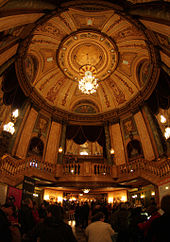
Sydney's first commercial theatre opened in 1832 and nine more had commenced performances by the late 1920s. The live medium lost much of its popularity to the cinema during the Great Depression before experiencing a revival after World War II.[360] Prominent theatres in the city today include State Theatre, Theatre Royal, Sydney Theatre, The Wharf Theatre, and Capitol Theatre. Sydney Theatre Company maintains a roster of local, classical, and international plays. It occasionally features Australian theatre icons such as David Williamson, Hugo Weaving, and Geoffrey Rush. The city's other prominent theatre companies are New Theatre, Belvoir, and Griffin Theatre Company. Sydney is also home to Event Cinemas' first theatre, which opened on George St in 1913, under its former Greater Union brand; the theatre currently operates, and is regarded as one of Australia's busiest cinema locations.
The Sydney Opera House is the home of Opera Australia and Sydney Symphony. It has staged over 100,000 performances and received 100 million visitors since opening in 1973.[245] Two other important performance venues in Sydney are Town Hall and the City Recital Hall. The Sydney Conservatorium of Music is located adjacent to the Royal Botanic Garden and serves the Australian music community through education and its biannual Australian Music Examinations Board exams.[361]
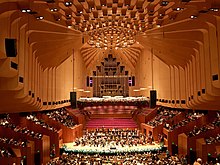
Many writers have originated in and set their work in Sydney. Others have visited the city and commented on it. Some of them are commemorated in the Sydney Writers Walk at Circular Quay. The city was the headquarters for Australia's first published newspaper, the Sydney Gazette.[362] Watkin Tench's A Narrative of the Expedition to Botany Bay (1789) and A Complete Account of the Settlement at Port Jackson in New South Wales (1793) have remained the best-known accounts of life in early Sydney.[363] Since the infancy of the establishment, much of the literature set in Sydney were concerned with life in the city's slums and working-class communities, notably William Lane's The Working Man's Paradise (1892), Christina Stead's Seven Poor Men of Sydney (1934) and Ruth Park's The Harp in the South (1948).[364] The first Australian-born female novelist, Louisa Atkinson, set several novels in Sydney.[365] Contemporary writers, such as Elizabeth Harrower, were born in the city and set most of their work there–Harrower's debut novel Down in the City (1957) was mostly set in a King's Cross apartment.[366][367][368] Well known contemporary novels set in the city include Melina Marchetta's Looking for Alibrandi (1992), Peter Carey's 30 Days in Sydney: A Wildly Distorted Account (1999), J. M. Coetzee's Diary of a Bad Year (2007) and Kate Grenville's The Secret River (2010). The Sydney Writers' Festival is held annually between April and May.[369]
Filmmaking in Sydney was prolific until the 1920s when spoken films were introduced and American productions gained dominance.[370] The Australian New Wave saw a resurgence in film production, with many notable features shot in the city between the 1970s and 80s, helmed by directors such as Bruce Beresford, Peter Weir and Gillian Armstrong.[371] Fox Studios Australia commenced production in Sydney in 1998. Successful films shot in Sydney since then include The Matrix, Lantana, Mission: Impossible 2, Moulin Rouge!, Star Wars: Episode II – Attack of the Clones, Australia, Superman Returns, The Great Gatsby and Anyone but You. The National Institute of Dramatic Art is based in Sydney and has several famous alumni such as Mel Gibson, Judy Davis, Baz Luhrmann, Cate Blanchett, Hugo Weaving and Jacqueline Mckenzie.[372]
Sydney hosts several festivals throughout the year. The city's New Year's Eve celebrations are the largest in Australia.[373] The Royal Easter Show is held every year at Sydney Olympic Park. Sydney Festival is Australia's largest arts festival.[374] The travelling rock music festival Big Day Out originated in Sydney. The city's two largest film festivals are Sydney Film Festival and Tropfest. Vivid Sydney is an annual outdoor exhibition of art installations, light projections, and music. In 2015, Sydney was ranked the 13th top fashion capital in the world.[375] It hosts the Australian Fashion Week in autumn. Sydney Mardi Gras has commenced each February since 1979.
Sydney's Chinatown has had numerous locations since the 1850s. It moved from George Street to Campbell Street to its current setting in Dixon Street in 1980.[376] Little Italy is located in Stanley Street.[287]
Restaurants, bars and nightclubs can be found in the entertainment hubs in the Sydney CBD (Darling Harbour, Barangaroo, The Rocks and George Street), Oxford Street, Surry Hills, Newtown and Parramatta.[377][378] Kings Cross was previously considered the red-light district. The Star is the city's casino and is situated next to Darling Harbour while the new Crown Sydney resort is in nearby Barangaroo.[379]
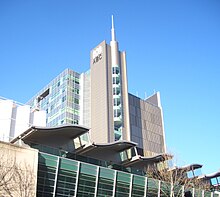
The Sydney Morning Herald is Australia's oldest newspaper still in print; it has been published continuously since 1831.[380] Its competitor is The Daily Telegraph, in print since 1879.[381] Both papers have Sunday tabloid editions called The Sun-Herald and The Sunday Telegraph respectively. The Bulletin was founded in Sydney in 1880 and became Australia's longest running magazine. It closed after 128 years of continuous publication.[382] Sydney heralded Australia's first newspaper, the Sydney Gazette, published until 1842.
Each of Australia's three commercial television networks and two public broadcasters is headquartered in Sydney. Nine's offices and news studios are in North Sydney, Ten is based in Pyrmont, and Seven is based in South Eveleigh in Redfern.[383][384][385][386] The Australian Broadcasting Corporation is located in Ultimo,[387] and the Special Broadcasting Service is based in Artarmon.[388] Multiple digital channels have been provided by all five networks since 2000. Foxtel is based in North Ryde and sells subscription cable television to most of the urban area.[389] Sydney's first radio stations commenced broadcasting in the 1920s. Radio has managed to survive despite the introduction of television and the Internet.[390] 2UE was founded in 1925 and under the ownership of Nine Entertainment is the oldest station still broadcasting.[390] Competing stations include the more popular 2GB, ABC Radio Sydney, KIIS 106.5, Triple M, Nova 96.9 and 2Day FM.[391]
Sydney's earliest migrants brought with them a passion for sport but were restricted by the lack of facilities and equipment. The first organised sports were boxing, wrestling, and horse racing from 1810 in Hyde Park.[392] Horse racing remains popular and events such as the Golden Slipper Stakes attract widespread attention. The first cricket club was formed in 1826 and matches were played within Hyde Park throughout the 1830s and 1840s.[392] Cricket is a favoured sport in summer and big matches have been held at the Sydney Cricket Ground since 1878. The New South Wales Blues compete in the Sheffield Shield league and the Sydney Sixers and Sydney Thunder contest the national Big Bash Twenty20 competition.
First played in Sydney in 1865, rugby grew to be the city's most popular football code by the 1880s. One-tenth of the state's population attended a New South Wales versus New Zealand rugby match in 1907.[392] Rugby league separated from rugby union in 1908. The New South Wales Waratahs contest the Super Rugby competition, while the Sydney Rays represent the city in the National Rugby Championship. The national Wallabies rugby union team competes in Sydney in international matches such as the Bledisloe Cup, Rugby Championship, and World Cup. Sydney is home to nine of the seventeen teams in the National Rugby League competition: Canterbury-Bankstown Bulldogs, Cronulla-Sutherland Sharks, Manly-Warringah Sea Eagles, Penrith Panthers, Parramatta Eels, South Sydney Rabbitohs, St George Illawarra Dragons, Sydney Roosters, and Wests Tigers. New South Wales contests the annual State of Origin series against Queensland.
Sydney FC and the Western Sydney Wanderers compete in the A-League Men and A-League Women competitions. The Sydney Swans and Greater Western Sydney Giants are local Australian rules football clubs that play in the Australian Football League and the AFL Women's. The Sydney Kings compete in the National Basketball League. The Sydney Uni Flames play in the Women's National Basketball League. The Sydney Blue Sox contest the Australian Baseball League. The NSW Pride are a member of the Hockey One League. The Sydney Bears and Sydney Ice Dogs play in the Australian Ice Hockey League. The Swifts are competitors in the national women's netball league.

Women were first allowed to participate in recreational swimming when separate baths were opened at Woolloomooloo Bay in the 1830s. From being illegal at the beginning of the century, sea bathing gained immense popularity during the early 1900s and the first surf lifesaving club was established at Bondi Beach.[392][393] Disputes about appropriate clothing for surf bathing surfaced occasionally and concerned men as well as women. The City2Surf is an annual 14 km (8.7 mi) running race from the CBD to Bondi Beach and has been held since 1971. In 2010, 80,000 runners participated which made it the largest run of its kind in the world.[394]
Sailing races have been held on Sydney Harbour since 1827.[395] Yachting has been popular amongst wealthier residents since the 1840s and the Royal Sydney Yacht Squadron was founded in 1862. The Sydney to Hobart Yacht Race is a 1,170 km (727 mi) event that starts from Sydney Harbour on Boxing Day.[396] Since its inception in 1945 it has been recognised as one of the most difficult yacht races in the world.[397] Six sailors died and 71 vessels of 115 failed to finish in the 1998 edition.[398]

The Royal Sydney Golf Club is based in Rose Bay and since its opening in 1893 has hosted the Australian Open on 13 occasions.[392] Royal Randwick Racecourse opened in 1833 and holds several major cups throughout the year.[399]
Sydney benefitted from the construction of significant sporting infrastructure in preparation for its hosting of the 2000 Summer Olympics. The Sydney Olympic Park accommodates athletics, aquatics, tennis, hockey, archery, baseball, cycling, equestrian, and rowing facilities. It also includes the high capacity Stadium Australia used for rugby, soccer, and Australian rules football. The Sydney Football Stadium was completed in 1988 and was used for rugby and soccer matches. Sydney Cricket Ground was opened in 1878 and is used for both cricket and Australian rules football fixtures.[392]
Sydney was one of the host cities during the 2023 FIFA Women's World Cup. Sydney Football Stadium and Stadium Australia were selected as venues, with the later hosting the final.[400]
The Sydney International tennis tournament is held here at the beginning of each year as the warm-up for the Grand Slam in Melbourne. Two of the most successful tennis players in history (Ken Rosewall and Todd Woodbridge) were born in and live in the city.
Sydney co-hosted the FIBA Oceania Championship in 1979, 1985, 1989, 1995, 2007, 2009 and 2011.

The first five governors had near autocratic power in the colony of New South Wales, subject only to the laws of England and the supervision of the Colonial Office in London. Sydney was the seat of government for the colony which encompassed over half the Australian continent.[401] The first Legislative Council met in 1826,[402] and in 1842, the imperial parliament expanded and reformed the council, making it partly elected.[403] In the same year, the town of Sydney officially became a city and an elected municipal council was established.[404][405] The council had limited powers, mostly relating to services such as street lighting and drainage.[406] Its boundaries were restricted to an area of 11.6 square kilometres, taking in the city centre and the modern suburbs of Woolloomooloo, Surry Hills, Chippendale, and Pyrmont.[63] As Sydney grew, other municipal councils were formed to provide local administration.[407]
In 1856, New South Wales achieved responsible government with the introduction of a bicameral parliament, based in Sydney, comprising a directly elected Legislative Assembly and a nominated Legislative Council.[408] With the federation of the Australian colonies in 1901, Sydney became the capital of the state of New South Wales and its administration was divided between the Commonwealth, State and constituent local governments.[408]

In common with other Australian capital cities, Sydney has no single local government covering its whole area. Local government areas have responsibilities such as local roads, libraries, child care, community services and waste collection, whereas the state government retains responsibility for main roads, traffic control, public transport, policing, education, and major infrastructure project.[409] There are 33 local government areas which are wholly or mostly within Greater Sydney as defined by the Australian Statistical Geography Standard.[96][410]

Sydney is the location of the secondary official residences of the Governor-General and Prime Minister – Admiralty House and Kirribilli House respectively.[411] The Parliament of New South Wales sits in Parliament House on Macquarie Street. This building was completed in 1816 and first served as a hospital. The Legislative Council moved into its northern wing in 1829 and by 1852 had entirely supplanted the surgeons from their quarters.[412] Several additions have been made as the Parliament has expanded, but it retains its original Georgian façade.[413] Government House was completed in 1845 and has served as the home of 25 Governors and 5 Governors-General.[414] The Cabinet of Australia also meets in Sydney when needed.
The highest court in the state is the Supreme Court of New South Wales, located in Queen's Square.[415] The city is also the home of numerous branches of the intermediate District Court of New South Wales and the lower Local Court of New South Wales.[416]
In the past, the state has tended to resist amalgamating Sydney's more populated local government areas as merged councils could pose a threat to its governmental power.[417] Established in 1842, the City of Sydney is one such local government area and includes the CBD and some adjoining inner suburbs.[418] It is responsible for fostering development in the local area, providing local services (waste collection and recycling, libraries, parks, sporting facilities), promoting the interests of residents, supporting organisations that target the local community, and attracting and providing infrastructure for commerce, tourism, and industry.[419] The City of Sydney is led by an elected Council and Lord Mayor.[420]
In federal politics, Sydney was initially considered as a possibility for Australia's capital city; the newly created city of Canberra ultimately filled this role.[421] Seven Australian Prime Ministers have been born in Sydney, more than any other city, including first Prime Minister Edmund Barton and current Prime Minister Anthony Albanese.
Essential public emergency services are provided and managed by the State Government. Greater Sydney is served by:

Education became a focus for the colony from the 1870s when public schools began to form and schooling became compulsory.[422] By 2011, 90% of working age residents had completed some schooling and 57% had completed the highest level of school.[2] 1,390,703 people were enrolled in an educational institution in 2011 with 45.1% of these attending school and 16.5% studying at a university.[260] Undergraduate or postgraduate qualifications are held by 22.5% of working age Sydney residents and 40.2% of working age residents of the City of Sydney.[2][423] The most common fields of tertiary qualification are commerce (22.8%), engineering (13.4%), society and culture (10.8%), health (7.8%), and education (6.6%).[2]

There are six public universities based in Sydney: The University of Sydney, University of New South Wales, University of Technology Sydney, Macquarie University, Western Sydney University, and Australian Catholic University. Five public universities maintain secondary campuses in the city: the University of Notre Dame Australia, Central Queensland University, Victoria University, University of Wollongong, and University of Newcastle. Charles Sturt University and Southern Cross University operate secondary campuses only designated for international students. In addition, four public universities offer programs in Sydney through third-party providers: University of the Sunshine Coast, La Trobe University, Federation University Australia and Charles Darwin University. 5.2% of residents of Sydney are attending a university.[424] The University of New South Wales and the University of Sydney are ranked equal 19th in the world,[425] the University of Technology Sydney is ranked in the top 100,[425] while Macquarie University is ranked 237, and Western Sydney University is ranked 474.[426] Sydney has public, denominational, and independent schools. 7.8% of Sydney residents are attending primary school and 6.4% are enrolled in secondary school.[424] There are 935 public preschool, primary, and secondary schools in Sydney that are administered by the New South Wales Department of Education.[427] 14 of the 17 selective secondary schools in New South Wales are based in Sydney.[428]
Public vocational education and training in Sydney are run by TAFE New South Wales and began with the opening of the Sydney Technical College in 1878.[238] The college became the Sydney Institute in 1992 and now operates alongside its sister TAFE facilities across the Sydney metropolitan area, namely the Northern Sydney Institute, the Western Sydney Institute, and the South Western Sydney Institute. At the 2011 census, 2.4% of Sydney residents are enrolled in a TAFE course.[424]

The first hospital in the new colony was a collection of tents at The Rocks. Many of the convicts that survived the trip suffered from dysentery, smallpox, scurvy, and typhoid. Healthcare facilities remained inadequate despite the arrival of a prefabricated hospital with the Second Fleet and the construction of new hospitals at Parramatta, Windsor, and Liverpool in the 1790s.[429]
Governor Macquarie arranged for the construction of Sydney Hospital, completed in 1816.[429] Parts of the facility have been repurposed for use as Parliament House but the hospital itself still operates. The city's first emergency department was established at Sydney Hospital in 1870. Demand for emergency medical care increased from 1895 with the introduction of an ambulance service.[429] The Sydney Hospital also housed Australia's first teaching facility for nurses, the Nightingale Wing, established with the input of Florence Nightingale in 1868.[430]
Healthcare was recognised as a right in the early 1900s and Sydney's public hospitals came under the oversight of the Government of New South Wales.[429] The administration of healthcare across Sydney is handled by eight local health districts: Central Coast, Illawarra Shoalhaven, Sydney, Nepean Blue Mountains, Northern Sydney, South Eastern Sydney, South Western Sydney, and Western Sydney.[431] The Prince of Wales Hospital was established in 1852 and became the first of several major hospitals to be opened.[432] St Vincent's Hospital was founded in 1857,[176] followed by Royal Alexandra Hospital for Children in 1880,[433] the Prince Henry Hospital in 1881,[434] the Royal Prince Alfred Hospital in 1882,[435] the Royal North Shore Hospital in 1885,[436] the St George Hospital in 1894,[437] and the Nepean Hospital in 1895.[438] Westmead Hospital in 1978 was the last major facility to open.[439]
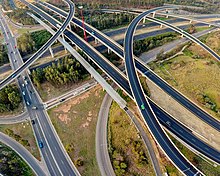
The motor vehicle, more than any other factor, has determined the pattern of Sydney's urban development since World War II.[440] The growth of low-density housing in the city's outer suburbs has made car ownership necessary for hundreds of thousands of households. The percentage of trips taken by car has increased from 13% in 1947 to 50% in 1960 and 70% in 1971.[440] The most important roads in Sydney were the nine Metroads, including the 110 km (68 mi) Sydney Orbital Network. Sydney's reliance on motor vehicles and its sprawling road network has been criticised by proponents of mass public transport and high-density housing.[441][442][443] The Light Horse Interchange in western Sydney is the largest in the southern hemisphere.[444]
There can be up to 350,000 cars using Sydney's roads simultaneously during peak hour, leading to significant traffic congestion.[440] 84.9% of Sydney households own a motor vehicle and 46.5% own two or more.[260] With a rate of 26.3% in 2014, Sydney has the highest utilisation of public transport for travel to work of any Australian capital.[445] In contrast, in 2014 only 25.2% of working residents in the City of Sydney use a car, whilst 15.8% take a train, 13.3% use a bus, and 25.3% walk.[446] Several significant infrastructure projects have been completed since. The CBD features a series of alleyways and lanes that provide off-street vehicular access to city buildings and as well as pedestrian routes through city buildings.[447]

Established in 1906, Central station is the largest and busiest railway station in the state and is the main hub of the city's rail network.[448] Sydney Trains is the suburban rail service. Its tracks form part of the New South Wales railway network. It serves 168 stations across the city and had an annual ridership of 302 million passenger journeys in 2023–24.[449] Sydney's railway was first constructed in 1854 with progressive extension to the network to serve both freight and passengers. The main station is the Central railway station in the southern part of the CBD. In the 1850s and 1860s, the railway reached areas that are now outer suburbs of Sydney.[440]
Sydney Metro, a driverless rapid transit system separate from the suburban commuter network, commenced operation in May 2019 and was extended through the city to Sydenham on 19 August 2024. This line will be extended to Bankstown in 2025 and a new line through the inner west to Parramatta is planned to be built by 2030.[450][451] It currently serves 21 stations. A line to serve the greater west is planned for 2026 and will include a station for the second international airport.

Sydney once had one of the largest tram networks in the British Empire after London.[452] It served routes covering 291 km (181 mi). The internal combustion engine made buses more flexible than trams and consequently more popular, leading to the progressive closure of the network with the final tram operating in 1961.[440] From 1930 there were 612 buses across Sydney carrying 90 million passengers per annum.[453]
In 1997, the Inner West Light Rail opened between Central station and Wentworth Park. It was extended to Lilyfield in 2000 and then Dulwich Hill in 2014. It links the Inner West and Darling Harbour with Central station and facilitated 9.1 million journeys in the 2016–17 financial year.[454] A second, the CBD and South East Light Rail 12 km (7.5 mi) line serving the CBD and Eastern Suburbs opened in 2019–2020.[455] A light rail line serving Western Sydney opened in 2024.
Bus services are conducted by private operators under contract to Transport for NSW. Integrated tickets called Opal cards operate on bus routes. In total, nearly 225 million boardings were recorded across the bus network.[456] NightRide is a nightly bus service that operate between midnight and 5am.

At the time the Sydney Harbour Bridge opened in 1932, the city's ferry service was the largest in the world.[457] Patronage declined from 37 million passengers in 1945 to 11 million in 1963 but has recovered somewhat in recent years.[440] From its hub at Circular Quay, the ferry network extends from Manly to Parramatta.[457] Ferries in sydney are operated by Transdev Sydney Ferries and operates 10 routes.
Sydney Airport, officially "Sydney Kingsford-Smith Airport", is located in Mascot. It services 46 international and 23 domestic destinations.[26] As the busiest airport in Australia, it handled 37.9 million passengers in 2013 and 530,000 tonnes of freight in 2011.[26] A second airport, Western Sydney Airport, is under construction at Badgerys Creek and will open in late 2026,[458] at a cost of $2.5 billion.[459] Notably, it will not feature a curfew, unlike Sydney Kingsford-Smith Airport, which imposes a suspension of all aircraft operations between 11 pm and 6 am. Bankstown Airport is Sydney's second busiest airport, and serves general aviation, charter and some scheduled cargo flights. Bankstown is also the fourth busiest airport in Australia by number of aircraft movements.[460] Port Botany has surpassed Port Jackson as the city's major shipping port. Cruise ship terminals are located at Sydney Cove and White Bay.

Obtaining sufficient fresh water was difficult during early colonial times. A catchment called the Tank Stream sourced water from what is now the CBD but was little more than an open sewer by the end of the 1700s.[461] The Botany Swamps Scheme was one of several ventures during the mid-1800s that saw the construction of wells, tunnels, steam pumping stations, and small dams to service Sydney's growing population.[461]
The Upper Nepean Scheme came into operation in 1886. It transports water 100 km (62 mi) from the Nepean, Cataract, and Cordeaux rivers and continues to service about 15% of Sydney's water needs.[461] Dams were built on these three rivers between 1907 and 1935.[461] In 1977 the Shoalhaven Scheme brought several more dams into service.[462]
The state-owned corporation WaterNSW now manages eleven major dams: Warragamba, one of the largest domestic water supply dams in the world,[463] Woronora, Cataract, Cordeaux, Nepean, Avon, Wingecarribee Reservoir, Fitzroy Falls Reservoir, Tallowa, the Blue Mountains Dams, and Prospect Reservoir.[464] Water is collected from five catchment areas covering 16,000 km2 (6,178 sq mi) and total storage amounts to 2.6 TL (0.6 cu mi).[464] The Sydney Desalination Plant came into operation in 2010.[461] WaterNSW supplies bulk water to Sydney Water, a state-owned corporation that operates water distribution, sewerage and storm water management services.
Sydney's electricity infrastructure is maintained by Ausgrid and Endeavour Energy.[465][466] Their combined networks include over 815,000 poles and 83,000 km (52,000 mi) of cables. Submarine communications cable systems in Sydney include the Australia–Japan Cable, Telstra Endeavour and the Southern Cross Cable, which link Australia and countries in the Pacific.[467][468][469]

As climate change, greenhouse gas emissions and pollution have become a major issue for Australia, Sydney has in the past been criticised for its lack of focus on reducing pollution and emissions and maintaining water quality.[470] The release of the Metropolitan Air Quality Scheme (MAQS) led to a broader understanding of the causation of pollution in Sydney, allowing the government to form appropriate responses.[471]
The 2019–20 Australian bushfire season significantly impacted outer Sydney and dramatically reduced air quality, leading to a smoky haze that lingered for days. The air quality was 11 times the hazardous level in some days,[472][473] worse than New Delhi's;[474] it was compared to "smoking 32 cigarettes" by Brian Oliver, a respiratory diseases scientist at the University of Technology Sydney.[475] Since Sydney is surrounded by bushland and forest,[476] bushfires can ring the region in a natural phenomena that is labelled "ring of fire".[477][478][479][480][481]
The City of Sydney became the first council in Australia to achieve formal certification as carbon-neutral in 2008.[482][483] The city has reduced its 2007 carbon emissions by 6% and since 2006 has reduced carbon emissions from city buildings by up to 20%.[484][485] The Sustainable Sydney 2030 program presented a guide to reducing energy in homes and offices by 30%.[484][486] Reductions in energy consumption have slashed energy bills by $30 million a year.[487] Solar panels have been established on many CBD buildings to minimise carbon pollution by around 3,000 tonnes a year.[488]
The city also has an "urban forest growth strategy", in which it aims to regularly increase the tree coverage in the city by frequently planting trees with strong leaf density and vegetation to provide cleaner air and create moisture during hot weather, thus lowering city temperatures.[489] Sydney has also become a leader in the development of green office buildings and enforcing the requirement of all building proposals to be energy-efficient. The One Central Park development, completed in 2013, is an example of this implementation.[490][491][492][493]

Australian cities are some of the most car-dependent cities in the world,[494] especially by world city standards, although Sydney's is the lowest of Australia's major cities at 66%.[495] Sydney also has the highest usage of public transport in an Australian city, at 27%–comparable with New York City, Shanghai and Berlin. Despite its high ranking for an Australian city, Sydney has a low level of mass-transit services, with a historically low-density layout and significant urban sprawl, thus increasing the likelihood of car dependency.[496][497]
Strategies have been implemented to reduce private vehicle pollution by encouraging mass and public transit,[498] initiating the development of high density housing and introducing a fleet of 10 new electric cars, the largest order of the pollution-free vehicle in Australia.[499] Electric cars do not produce carbon monoxide and nitrous oxide, which contribute to climate change.[500][501] Cycling trips increased by 113% across Sydney's inner-city from 2010 to 2015, at which point about 2,000 bikes were passing through top peak-hour intersections on an average weekday.[484] Transport developments in the north-west and east of the city have been designed to encourage use of the expanding public transportation system.
Sister cities of Sydney include:
In this year's World's Best Awards, announced in New York this week, Sydney came in as the world's number 12 ranked best city.
cite web: CS1 maint: multiple names: authors list (link)Brisbane and Sydney each have a humid sub-tropical or temperate climate with no pronounced dry season...the classification is Cfa
Mr Zmijewski doubted the 1836 snow report, saying weather observers of the era lacked the expertise of today. "We are almost in the sub-tropics in Sydney", he said.
cite web: CS1 maint: multiple names: authors list (link)cite web: CS1 maint: archived copy as title (link)cite web: CS1 maint: multiple names: authors list (link)cite web: CS1 maint: date and year (link)
 |
|
|
Screenshot
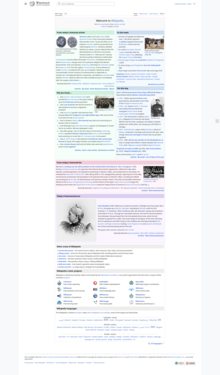
The Main Page of the English Wikipedia running an alpha version of MediaWiki 1.40
|
|
| Original author(s) | |
|---|---|
| Developer(s) | Wikimedia Foundation |
| Initial release | January 25, 2002 |
| Stable release |
1.43.0[1]
|
| Repository | |
| Written in | PHP[2] |
| Operating system | Windows, macOS, Linux, FreeBSD, OpenBSD, Solaris |
| Size | 79.05 MiB (compressed) |
| Available in | 459[3] languages |
| Type | Wiki software |
| License | GPLv2+[4] |
| Website | mediawiki |
MediaWiki is free and open-source wiki software originally developed by Magnus Manske for use on Wikipedia on January 25, 2002, and further improved by Lee Daniel Crocker,[5][6] after which development has been coordinated by the Wikimedia Foundation. It powers several wiki hosting websites across the Internet, as well as most websites hosted by the Wikimedia Foundation including Wikipedia, Wiktionary, Wikimedia Commons, Wikiquote, Meta-Wiki and Wikidata, which define a large part of the set requirements for the software.[7] Besides its usage on Wikimedia sites, MediaWiki has been used as a knowledge management and content management system on websites such as Fandom, wikiHow and major internal installations like Intellipedia and Diplopedia.
MediaWiki is written in the PHP programming language and stores all text content into a database. The software is optimized to efficiently handle large projects, which can have terabytes of content and hundreds of thousands of views per second.[7][8] Because Wikipedia is one of the world's largest and most visited websites, achieving scalability through multiple layers of caching and database replication has been a major concern for developers. Another major aspect of MediaWiki is its internationalization; its interface is available in more than 400 languages.[9] The software has hundreds of configuration settings[10] and more than 1,000 extensions available for enabling various features to be added or changed.[11]
MediaWiki provides a rich core feature set and a mechanism to attach extensions to provide additional functionality.
Due to the strong emphasis on multilingualism in the Wikimedia projects, internationalization and localization has received significant attention by developers. The user interface has been fully or partially translated into more than 400 languages on translatewiki.net,[9] and can be further customized by site administrators (the entire interface is editable through the wiki).
Several extensions, most notably those collected in the MediaWiki Language Extension Bundle, are designed to further enhance the multilingualism and internationalization of MediaWiki.
Installation of MediaWiki requires that the user have administrative privileges on a server running both PHP and a compatible type of SQL database. Some users find that setting up a virtual host is helpful if the majority of one's site runs under a framework (such as Zope or Ruby on Rails) that is largely incompatible with MediaWiki.[12] Cloud hosting can eliminate the need to deploy a new server.[13]
An installation PHP script is accessed via a web browser to initialize the wiki's settings. It prompts the user for a minimal set of required parameters, leaving further changes, such as enabling uploads,[14] adding a site logo,[15] and installing extensions, to be made by modifying configuration settings contained in a file called LocalSettings.php.[16] Some aspects of MediaWiki can be configured through special pages or by editing certain pages; for instance, abuse filters can be configured through a special page,[17] and certain gadgets can be added by creating JavaScript pages in the MediaWiki namespace.[18] The MediaWiki community publishes a comprehensive installation guide.[19]
One of the earliest differences between MediaWiki (and its predecessor, UseModWiki) and other wiki engines was the use of "free links" instead of CamelCase. When MediaWiki was created, it was typical for wikis to require text like "WorldWideWeb" to create a link to a page about the World Wide Web; links in MediaWiki, on the other hand, are created by surrounding words with double square brackets, and any spaces between them are left intact, e.g. [[World Wide Web]]. This change was logical for the purpose of creating an encyclopedia, where accuracy in titles is important.
MediaWiki uses an extensible[20] lightweight wiki markup designed to be easier to use and learn than HTML. Tools exist for converting content such as tables between MediaWiki markup and HTML.[21] Efforts have been made to create a MediaWiki markup spec, but a consensus seems to have been reached that Wikicode requires context-sensitive grammar rules.[22][23] The following side-by-side comparison illustrates the differences between wiki markup and HTML:
| MediaWiki syntax (the "behind the scenes" code used to add formatting to text) |
HTML equivalent (another type of "behind the scenes" code used to add formatting to text) |
Rendered output (seen onscreen by a site viewer) |
|---|---|---|
====A dialogue====
"Take some more [[tea]]," the March Hare said to Alice, very earnestly.
"I've had nothing yet," Alice replied in an offended tone: "so I can't take more."
"You mean you can't take ''less''," said the Hatter: "it's '''very''' easy to take ''more'' than nothing."
|
<h4>A dialogue</h4>
<p>"Take some more <a href="/wiki/Tea" title="Tea">tea</a>," the March Hare said to Alice, very earnestly.</p> <br>
<p>"I've had nothing yet," Alice replied in an offended tone: "so I can't take more."</p> <br>
<p>"You mean you can't take <i>less</i>," said the Hatter: "it's <b>very</b> easy to take <i>more</i> than nothing."</p>
|
A dialogue
"Take some more tea," the March Hare said to Alice, very earnestly. "I've had nothing yet," Alice replied in an offended tone: "so I can't take more." "You mean you can't take less," said the Hatter: "it's very easy to take more than nothing." |
(Quotation above from Alice's Adventures in Wonderland by Lewis Carroll)

MediaWiki's default page-editing tools have been described as somewhat challenging to learn.[24] A survey of students assigned to use a MediaWiki-based wiki found that when they were asked an open question about main problems with the wiki, 24% cited technical problems with formatting, e.g. "Couldn't figure out how to get an image in. Can't figure out how to show a link with words; it inserts a number."[25]
To make editing long pages easier, MediaWiki allows the editing of a subsection of a page (as identified by its header). A registered user can also indicate whether or not an edit is minor. Correcting spelling, grammar or punctuation are examples of minor edits, whereas adding paragraphs of new text is an example of a non-minor edit.
Sometimes while one user is editing, a second user saves an edit to the same part of the page. Then, when the first user attempts to save the page, an edit conflict occurs. The second user is then given an opportunity to merge their content into the page as it now exists following the first user's page save.
MediaWiki's user interface has been localized in many different languages. A language for the wiki content itself can also be set, to be sent in the "Content-Language" HTTP header and "lang" HTML attribute.
VisualEditor has its own integrated wikitext editing interface known as 2017 wikitext editor, the older editing interface is known as 2010 wikitext editor.
MediaWiki has an extensible web API (application programming interface) that provides direct, high-level access to the data contained in the MediaWiki databases. Client programs can use the API to log in, get data, and post changes. The API supports thin web-based JavaScript clients and end-user applications (such as vandal-fighting tools). The API can be accessed by the backend of another web site.[26] An extensive Python bot library, Pywikibot,[27] and a popular semi-automated tool called AutoWikiBrowser, also interface with the API.[28] The API is accessed via URLs such as https://en.wikipedia.org/w/api.php?action=query&list=recentchanges. In this case, the query would be asking Wikipedia for information relating to the last 10 edits to the site. One of the perceived advantages of the API is its language independence; it listens for HTTP connections from clients and can send a response in a variety of formats, such as XML, serialized PHP, or JSON.[29] Client code has been developed to provide layers of abstraction to the API.[30]
Among the features of MediaWiki to assist in tracking edits is a Recent Changes feature that provides a list of recent edits to the wiki. This list contains basic information about those edits such as the editing user, the edit summary, the page edited, as well as any tags (e.g. "possible vandalism")[31] added by customizable abuse filters and other extensions to aid in combating unhelpful edits.[32] On more active wikis, so many edits occur that it is hard to track Recent Changes manually. Anti-vandal software, including user-assisted tools,[33] is sometimes employed on such wikis to process Recent Changes items. Server load can be reduced by sending a continuous feed of Recent Changes to an IRC channel that these tools can monitor, eliminating their need to send requests for a refreshed Recent Changes feed to the API.[34][35]
Another important tool is watchlisting. Each logged-in user has a watchlist to which the user can add whatever pages he or she wishes. When an edit is made to one of those pages, a summary of that edit appears on the watchlist the next time it is refreshed.[36] As with the recent changes page, recent edits that appear on the watchlist contain clickable links for easy review of the article history and specific changes made.
There is also the capability to review all edits made by any particular user. In this way, if an edit is identified as problematic, it is possible to check the user's other edits for issues.
MediaWiki allows one to link to specific versions of articles. This has been useful to the scientific community, in that expert peer reviewers could analyse articles, improve them and provide links to the trusted version of that article.[37]
Navigation through the wiki is largely through internal wikilinks. MediaWiki's wikilinks implement page existence detection, in which a link is colored blue if the target page exists on the local wiki and red if it does not. If a user clicks on a red link, they are prompted to create an article with that title. Page existence detection makes it practical for users to create "wikified" articles—that is, articles containing links to other pertinent subjects—without those other articles being yet in existence.
Interwiki links function much the same way as namespaces. A set of interwiki prefixes can be configured to cause, for instance, a page title of wikiquote:Jimbo Wales to direct the user to the Jimbo Wales article on Wikiquote.[38] Unlike internal wikilinks, interwiki links lack page existence detection functionality, and accordingly there is no way to tell whether a blue interwiki link is broken or not.
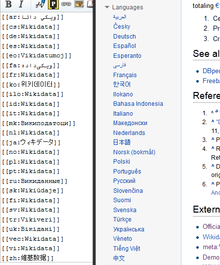
Interlanguage links are the small navigation links that show up in the sidebar in most MediaWiki skins that connect an article with related articles in other languages within the same Wiki family. This can provide language-specific communities connected by a larger context, with all wikis on the same server or each on its own server.[39]
Previously, Wikipedia used interlanguage links to link an article to other articles on the same topic in other editions of Wikipedia. This was superseded by the launch of Wikidata.[40]

Page tabs are displayed at the top of pages. These tabs allow users to perform actions or view pages that are related to the current page. The available default actions include viewing, editing, and discussing the current page. The specific tabs displayed depend on whether the user is logged into the wiki and whether the user has sysop privileges on the wiki. For instance, the ability to move a page or add it to one's watchlist is usually restricted to logged-in users. The site administrator can add or remove tabs by using JavaScript or installing extensions.[41]
Each page has an associated history page from which the user can access every version of the page that has ever existed and generate diffs between two versions of his choice. Users' contributions are displayed not only here, but also via a "user contributions" option on a sidebar. In a 2004 article, Carl Challborn and Teresa Reimann noted that "While this feature may be a slight deviation from the collaborative, 'ego-less' spirit of wiki purists, it can be very useful for educators who need to assess the contribution and participation of individual student users."[42]
MediaWiki provides many features beyond hyperlinks for structuring content. One of the earliest such features is namespaces. One of Wikipedia's earliest problems had been the separation of encyclopedic content from pages pertaining to maintenance and communal discussion, as well as personal pages about encyclopedia editors. Namespaces are prefixes before a page title (such as "User:" or "Talk:") that serve as descriptors for the page's purpose and allow multiple pages with different functions to exist under the same title. For instance, a page titled "[[The Terminator]]", in the default namespace, could describe the 1984 movie starring Arnold Schwarzenegger, while a page titled "[[User:The Terminator]]" could be a profile describing a user who chooses this name as a pseudonym. More commonly, each namespace has an associated "Talk:" namespace, which can be used to discuss its contents, such as "User talk:" or "Template talk:". The purpose of having discussion pages is to allow content to be separated from discussion surrounding the content.[43][44]
Namespaces can be viewed as folders that separate different basic types of information or functionality. Custom namespaces can be added by the site administrators. There are 16 namespaces by default for content, with 2 "pseudo-namespaces" used for dynamically generated "Special:" pages and links to media files. Each namespace on MediaWiki is numbered: content page namespaces have even numbers and their associated talk page namespaces have odd numbers.[45]
Users can create new categories and add pages and files to those categories by appending one or more category tags to the content text. Adding these tags creates links at the bottom of the page that take the reader to the list of all pages in that category, making it easy to browse related articles.[46] The use of categorization to organize content has been described as a combination of:
In addition to namespaces, content can be ordered using subpages. This simple feature provides automatic breadcrumbs of the pattern [[Page title/Subpage title]] from the page after the slash (in this case, "Subpage title") to the page before the slash (in this case, "Page title").

If the feature is enabled, users can customize their stylesheets and configure client-side JavaScript to be executed with every pageview. On Wikipedia, this has led to a large number of additional tools and helpers developed through the wiki and shared among users. For instance, navigation popups is a custom JavaScript tool that shows previews of articles when the user hovers over links and also provides shortcuts for common maintenance tasks.[48]

The entire MediaWiki user interface can be edited through the wiki itself by users with the necessary permissions (typically called "administrators"). This is done through a special namespace with the prefix "MediaWiki:", where each page title identifies a particular user interface message. Using an extension,[49] it is also possible for a user to create personal scripts, and to choose whether certain sitewide scripts should apply to them by toggling the appropriate options in the user preferences page.
The "MediaWiki:" namespace was originally also used for creating custom text blocks that could then be dynamically loaded into other pages using a special syntax. This content was later moved into its own namespace, "Template:".
Templates are text blocks that can be dynamically loaded inside another page whenever that page is requested. The template is a special link in double curly brackets (for example "Disputed"), which calls the template (in this case located at Template:Disputed) to load in place of the template call.
Templates are structured documents containing attribute–value pairs. They are defined with parameters, to which are assigned values when transcluded on an article page. The name of the parameter is delimited from the value by an equals sign. A class of templates known as infoboxes is used on Wikipedia to collect and present a subset of information about its subject, usually on the top (mobile view) or top right-hand corner (desktop view) of the document.
Pages in other namespaces can also be transcluded as templates. In particular, a page in the main namespace can be transcluded by prefixing its title with a colon; for example, :MediaWiki transcludes the article "MediaWiki" from the main namespace. Also, it is possible to mark the portions of a page that should be transcluded in several ways, the most basic of which are:[50]
<noinclude>...</noinclude>, which marks content that is not to be transcluded;<includeonly>...</includeonly>, which marks content that is not rendered unless it is transcluded;<onlyinclude>...</onlyinclude>, which marks content that is to be the only content transcluded.A related method, called template substitution (called by adding subst: at the beginning of a template link) inserts the contents of the template into the target page (like a copy and paste operation), instead of loading the template contents dynamically whenever the page is loaded. This can lead to inconsistency when using templates, but may be useful in certain cases, and in most cases requires fewer server resources (the actual amount of savings can vary depending on wiki configuration and the complexity of the template).
Templates have found many different uses. Templates enable users to create complex table layouts that are used consistently across multiple pages, and where only the content of the tables gets inserted using template parameters. Templates are frequently used to identify problems with a Wikipedia article by putting a template in the article. This template then outputs a graphical box stating that the article content is disputed or in need of some other attention, and also categorize it so that articles of this nature can be located. Templates are also used on user pages to send users standard messages welcoming them to the site,[51] giving them awards for outstanding contributions,[52][53] warning them when their behavior is considered inappropriate,[54] notifying them when they are blocked from editing,[55] and so on.
MediaWiki offers flexibility in creating and defining user groups. For instance, it would be possible to create an arbitrary "ninja" group that can block users and delete pages, and whose edits are hidden by default in the recent changes log. It is also possible to set up a group of "autoconfirmed" users that one becomes a member of after making a certain number of edits and waiting a certain number of days.[56] Some groups that are enabled by default are bureaucrats and sysops. Bureaucrats have the power to change other users' rights. Sysops have power over page protection and deletion and the blocking of users from editing. MediaWiki's available controls on editing rights have been deemed sufficient for publishing and maintaining important documents such as a manual of standard operating procedures in a hospital.[57]
MediaWiki comes with a basic set of features related to restricting access, but its original and ongoing design is driven by functions that largely relate to content, not content segregation. As a result, with minimal exceptions (related to specific tools and their related "Special" pages), page access control has never been a high priority in core development and developers have stated that users requiring secure user access and authorization controls should not rely on MediaWiki, since it was never designed for these kinds of situations. For instance, it is extremely difficult to create a wiki where only certain users can read and access some pages.[58] Here, wiki engines like Foswiki, MoinMoin and Confluence provide more flexibility by supporting advanced security mechanisms like access control lists.
The MediaWiki codebase contains various hooks using callback functions to add additional PHP code in an extensible way. This allows developers to write extensions without necessarily needing to modify the core or having to submit their code for review. Installing an extension typically consists of adding a line to the configuration file, though in some cases additional changes such as database updates or core patches are required.
Five main extension points were created to allow developers to add features and functionalities to MediaWiki. Hooks are run every time a certain event happens; for instance, the ArticleSaveComplete hook occurs after a save article request has been processed.[59] This can be used, for example, by an extension that notifies selected users whenever a page edit occurs on the wiki from new or anonymous users.[60] New tags can be created to process data with opening and closing tags (<newtag>...</newtag>).[61] Parser functions can be used to create a new command (#if:...).[62] New special pages can be created to perform a specific function. These pages are dynamically generated. For example, a special page might show all pages that have one or more links to an external site or it might create a form providing user submitted feedback.[63] Skins allow users to customize the look and feel of MediaWiki.[64] A minor extension point allows the use of Amazon S3 to host image files.[65]
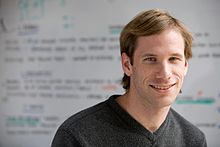
Among the most popular extensions is a parser function extension, ParserFunctions, which allows different content to be rendered based on the result of conditional statements.[66] These conditional statements can perform functions such as evaluating whether a parameter is empty, comparing strings, evaluating mathematical expressions, and returning one of two values depending on whether a page exists. It was designed as a replacement for a notoriously inefficient template called Qif.[67] Schindler recounts the history of the ParserFunctions extension as follows:[68]
In 2006 some Wikipedians discovered that through an intricate and complicated interplay of templating features and CSS they could create conditional wiki text, i.e. text that was displayed if a template parameter had a specific value. This included repeated calls of templates within templates, which bogged down the performance of the whole system. The developers faced the choice of either disallowing the spreading of an obviously desired feature by detecting such usage and explicitly disallowing it within the software or offering an efficient alternative. The latter was done by Tim Starling, who announced the introduction of parser functions, wiki text that calls functions implemented in the underlying software. At first, only conditional text and the computation of simple mathematical expressions were implemented, but this already increased the possibilities for wiki editors enormously. With time further parser functions were introduced, finally leading to a framework that allowed the simple writing of extension functions to add arbitrary functionalities, like e.g. geo-coding services or widgets. This time the developers were clearly reacting to the demand of the community, being forced either to fight the solution of the issue that the community had (i.e. conditional text), or offer an improved technical implementation to replace the previous practice and achieve an overall better performance.
Another parser functions extension, StringFunctions, was developed to allow evaluation of string length, string position, and so on. Wikimedia communities, having created awkward workarounds to accomplish the same functionality,[69] clamored for it to be enabled on their projects.[70] Much of its functionality was eventually integrated into the ParserFunctions extension,[71] albeit disabled by default and accompanied by a warning from Tim Starling that enabling string functions would allow users "to implement their own parsers in the ugliest, most inefficient programming language known to man: MediaWiki wikitext with ParserFunctions."[72]
Since 2012 an extension, Scribunto, has existed that allows for the creation of "modules"—wiki pages written in the scripting language Lua—which can then be run within templates and standard wiki pages. Scribunto has been installed on Wikipedia and other Wikimedia sites since 2013 and is used heavily on those sites. Scribunto code runs significantly faster than corresponding wikitext code using ParserFunctions.[73]
Another very popular extension is a citation extension that enables footnotes to be added to pages using inline references.[74] This extension has, however, been criticized for being difficult to use and requiring the user to memorize complex syntax. A gadget called RefToolbar attempts to make it easier to create citations using common templates. MediaWiki has some extensions that are well-suited for academia, such as mathematics extensions[75] and an extension that allows molecules to be rendered in 3D.[76]
A generic Widgets extension exists that allows MediaWiki to integrate with virtually anything. Other examples of extensions that could improve a wiki are category suggestion extensions[77] and extensions for inclusion of Flash Videos,[78] YouTube videos,[79] and RSS feeds.[80] Metavid, a site that archives video footage of the U.S. Senate and House floor proceedings, was created using code extending MediaWiki into the domain of collaborative video authoring.[81]
There are many spambots that search the web for MediaWiki installations and add linkspam to them, despite the fact that MediaWiki uses the nofollow attribute to discourage such attempts at search engine optimization.[82] Part of the problem is that third party republishers, such as mirrors, may not independently implement the nofollow tag on their websites, so marketers can still get PageRank benefit by inserting links into pages when those entries appear on third party websites.[83] Anti-spam extensions have been developed to combat the problem by introducing CAPTCHAs,[84] blacklisting certain URLs,[85] and allowing bulk deletion of pages recently added by a particular user.[86]

MediaWiki comes pre-installed with a standard text-based search. Extensions exist to let MediaWiki use more sophisticated third-party search engines, including Elasticsearch (which since 2014 has been in use on Wikipedia), Lucene[87] and Sphinx.[88]
Various MediaWiki extensions have also been created to allow for more complex, faceted search, on both data entered within the wiki and on metadata such as pages' revision history.[89][90] Semantic MediaWiki is one such extension.[91][92]
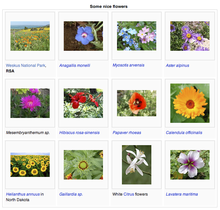
Various extensions to MediaWiki support rich content generated through specialized syntax. These include mathematical formulas using LaTeX, graphical timelines over mathematical plotting, musical scores and Egyptian hieroglyphs.
The software supports a wide variety of uploaded media files, and allows image galleries and thumbnails to be generated with relative ease. There is also support for Exif metadata. MediaWiki operates the Wikimedia Commons, one of the largest free content media archives.
For WYSIWYG editing, VisualEditor is available to use in MediaWiki which simplifying editing process for editors and has been bundled since MediaWiki 1.35.[93] Other extensions exist for handling WYSIWYG editing to different degrees.[94]
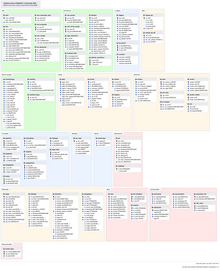
MediaWiki can use either the MySQL/MariaDB, PostgreSQL or SQLite relational database management system. Support for Oracle Database and Microsoft SQL Server has been dropped since MediaWiki 1.34.[95] A MediaWiki database contains several dozen tables, including a page table that contains page titles, page ids, and other metadata;[96] and a revision table to which is added a new row every time an edit is made, containing the page id, a brief textual summary of the change performed, the user name of the article editor (or its IP address the case of an unregistered user) and a timestamp.[97][98]
In a 4½ year period prior to 2008, the MediaWiki database had 170 schema versions.[99] Possibly the largest schema change was done in 2005 with MediaWiki 1.5, when the storage of metadata was separated from that of content, to improve performance flexibility. When this upgrade was applied to Wikipedia, the site was locked for editing, and the schema was converted to the new version in about 22 hours. Some software enhancement proposals, such as a proposal to allow sections of articles to be watched via watchlist, have been rejected because the necessary schema changes would have required excessive Wikipedia downtime.[100]
Because it is used to run one of the highest-traffic sites on the Web, Wikipedia, MediaWiki's performance and scalability have been highly optimized.[101] MediaWiki supports Squid, load-balanced database replication, client-side caching, memcached or table-based caching for frequently accessed processing of query results, a simple static file cache, feature-reduced operation, revision compression, and a job queue for database operations. MediaWiki developers have attempted to optimize the software by avoiding expensive algorithms, database queries, etc., caching every result that is expensive and has temporal locality of reference, and focusing on the hot spots in the code through profiling.[102]
MediaWiki code is designed to allow for data to be written to a read-write database and read from read-only databases, although the read-write database can be used for some read operations if the read-only databases are not yet up to date. Metadata, such as article revision history, article relations (links, categories etc.), user accounts and settings can be stored in core databases and cached; the actual revision text, being more rarely used, can be stored as append-only blobs in external storage. The software is suitable for the operation of large-scale wiki farms such as Wikimedia, which had about 800 wikis as of August 2011. However, MediaWiki comes with no built-in GUI to manage such installations.
Empirical evidence shows most revisions in MediaWiki databases tend to differ only slightly from previous revisions. Therefore, subsequent revisions of an article can be concatenated and then compressed, achieving very high data compression ratios of up to 100×.[102]
For more information on the architecture, such as how it stores wikitext and assembles a page, see External links.
The parser serves as the de facto standard for the MediaWiki syntax, as no formal syntax has been defined. Due to this lack of a formal definition, it has been difficult to create WYSIWYG editors for MediaWiki, although several WYSIWYG extensions do exist, including the popular VisualEditor.
MediaWiki is not designed to be a suitable replacement for dedicated online forum or blogging software,[103] although extensions do exist to allow for both of these.[104][105]
It is common for new MediaWiki users to make certain mistakes, such as forgetting to sign posts with four tildes (~~~~),[106] or manually entering a plaintext signature,[107] due to unfamiliarity with the idiosyncratic particulars involved in communication on MediaWiki discussion pages. On the other hand, the format of these discussion pages has been cited as a strength by one educator, who stated that it provides more fine-grain capabilities for discussion than traditional threaded discussion forums. For example, instead of 'replying' to an entire message, the participant in a discussion can create a hyperlink to a new wiki page on any word from the original page. Discussions are easier to follow since the content is available via hyperlinked wiki page, rather than a series of reply messages on a traditional threaded discussion forum. However, except in few cases, students were not using this capability, possibly because of their familiarity with the traditional linear discussion style and a lack of guidance on how to make the content more 'link-rich'.[108]
MediaWiki by default has little support for the creation of dynamically assembled documents, or pages that aggregate data from other pages. Some research has been done on enabling such features directly within MediaWiki.[109] The Semantic MediaWiki extension provides these features. It is not in use on Wikipedia, but in more than 1,600 other MediaWiki installations.[110] The Wikibase Repository and Wikibase Repository client are however implemented in Wikidata and Wikipedia respectively, and to some extent provides semantic web features, and linking of centrally stored data to infoboxes in various Wikipedia articles.
Upgrading MediaWiki is usually fully automated, requiring no changes to the site content or template programming. Historically troubles have been encountered when upgrading from significantly older versions.[111]
MediaWiki developers have enacted security standards, both for core code and extensions.[112] SQL queries and HTML output are usually done through wrapper functions that handle validation, escaping, filtering for prevention of cross-site scripting and SQL injection.[113] Many security issues have had to be patched after a MediaWiki version release,[114] and accordingly MediaWiki.org states, "The most important security step you can take is to keep your software up to date" by subscribing to the announcement mailing list and installing security updates that are announced.[115]
Support for MediaWiki users consists of:
MediaWiki is free and open-source and is distributed under the terms of the GNU General Public License version 2 or any later version. Its documentation, located at its official website at www.mediawiki.org, is released under the Creative Commons BY-SA 4.0 license, with a set of help pages intended to be freely copied into fresh wiki installations and/or distributed with MediaWiki software in the public domain instead to eliminate legal issues for wikis with other licenses.[119][120] MediaWiki's development has generally favored the use of open-source media formats.[121]
MediaWiki has an active volunteer community for development and maintenance. MediaWiki developers are spread around the world, though with a majority in the United States and Europe. Face-to-face meetings and programming sessions for MediaWiki developers have been held once or several times a year since 2004.[122]
Anyone can submit patches to the project's Git/Gerrit repository.[123] There are also paid programmers who primarily develop projects for the Wikimedia Foundation. MediaWiki developers participate in the Google Summer of Code by facilitating the assignment of mentors to students wishing to work on MediaWiki core and extension projects.[124] During the year prior to November 2012, there were about two hundred developers who had committed changes to the MediaWiki core or extensions.[125] Major MediaWiki releases are generated approximately every six months by taking snapshots of the development branch, which is kept continuously in a runnable state;[126] minor releases, or point releases, are issued as needed to correct bugs (especially security problems). MediaWiki is developed on a continuous integration development model, in which software changes are pushed live to Wikimedia sites on regular basis.[126] MediaWiki also has a public bug tracker, phabricator.wikimedia.org, which runs Phabricator. The site is also used for feature and enhancement requests.

When Wikipedia was launched in January 2001, it ran on an existing wiki software system, UseModWiki. UseModWiki is written in the Perl programming language, and stores all wiki pages in text (.txt) files. This software soon proved to be limiting, in both functionality and performance. In mid-2001, Magnus Manske—a developer and student at the University of Cologne, as well as a Wikipedia editor—began working on new software that would replace UseModWiki, specifically designed for use by Wikipedia. This software was written in the PHP scripting language, and stored all of its information in a MySQL database. The new software was largely developed by August 24, 2001, and a test wiki for it was established shortly thereafter.
The first full implementation of this software was the new Meta Wikipedia on November 9, 2001. There was a desire to have it implemented immediately on the English-language Wikipedia.[127] However, Manske was apprehensive about any potential bugs harming the nascent website during the period of the final exams he had to complete immediately prior to Christmas;[128] this led to the launch on the English-language Wikipedia being delayed until January 25, 2002. The software was then, gradually, deployed on all the Wikipedia language sites of that time. This software was referred to as "the PHP script" and as "phase II", with the name "phase I", retroactively given to the use of UseModWiki.
Increasing usage soon caused load problems to arise again, and soon after, another rewrite of the software began; this time being done by Lee Daniel Crocker, which became known as "phase III". This new software was also written in PHP, with a MySQL backend, and kept the basic interface of the phase II software, but with the added functionality of a wider scalability. The "phase III" software went live on Wikipedia in July 2002.
The Wikimedia Foundation was announced on June 20, 2003. In July, Wikipedia contributor Daniel Mayer suggested the name "MediaWiki" for the software, as a play on "Wikimedia".[129] The MediaWiki name was gradually phased in, beginning in August 2003. The name has frequently caused confusion due to its (intentional) similarity to the "Wikimedia" name (which itself is similar to "Wikipedia").[130] The first version of MediaWiki, 1.1, was released in December 2003.
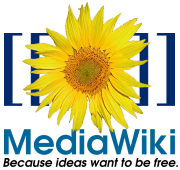
The old product logo was created by Erik Möller, using a flower photograph taken by Florence Nibart-Devouard, and was originally submitted to the logo contest for a new Wikipedia logo, held from July 20 to August 27, 2003.[131][132] The logo came in third place, and was chosen to represent MediaWiki rather than Wikipedia, with the second place logo being used for the Wikimedia Foundation.[133] The double square brackets ([[ ]]) symbolize the syntax MediaWiki uses for creating hyperlinks to other wiki pages; while the sunflower represents the diversity of content on Wikipedia, its constant growth, and the wilderness.[134]
Later, Brooke Vibber, the chief technical officer of the Wikimedia Foundation,[135] took up the role of release manager.[136][101]
Major milestones in MediaWiki's development have included: the categorization system (2004); parser functions, (2006); Flagged Revisions, (2008);[68] the "ResourceLoader", a delivery system for CSS and JavaScript (2011);[137] and the VisualEditor, a "what you see is what you get" (WYSIWYG) editing platform (2013).[138]
The contest of designing a new logo was initiated on June 22, 2020, as the old logo was a bitmap image and had "high details", leading to problems when rendering at high and low resolutions, respectively. After two rounds of voting, the new and current MediaWiki logo designed by Serhio Magpie was selected on October 24, 2020, and officially adopted on April 1, 2021.[139]
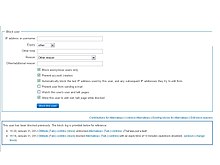
MediaWiki's most famous use has been in Wikipedia and, to a lesser degree, the Wikimedia Foundation's other projects. Fandom, a wiki hosting service formerly known as Wikia, runs on MediaWiki. Other public wikis that run on MediaWiki include wikiHow and SNPedia. WikiLeaks began as a MediaWiki-based site, but is no longer a wiki.
A number of alternative wiki encyclopedias to Wikipedia run on MediaWiki, including Citizendium, Metapedia, Scholarpedia and Conservapedia. MediaWiki is also used internally by a large number of companies, including Novell and Intel.[140][141]
Notable usages of MediaWiki within governments include Intellipedia, used by the United States Intelligence Community, Diplopedia, used by the United States Department of State, and milWiki, a part of milSuite used by the United States Department of Defense. United Nations agencies such as the United Nations Development Programme and INSTRAW chose to implement their wikis using MediaWiki, because "this software runs Wikipedia and is therefore guaranteed to be thoroughly tested, will continue to be developed well into the future, and future technicians on these wikis will be more likely to have exposure to MediaWiki than any other wiki software."[142]
The Free Software Foundation uses MediaWiki to implement the LibrePlanet site.[143]
Users of online collaboration software are familiar with MediaWiki's functions and layout due to its noted use on Wikipedia. A 2006 overview of social software in academia observed that "Compared to other wikis, MediaWiki is also fairly aesthetically pleasing, though simple, and has an easily customized side menu and stylesheet."[144] However, in one assessment in 2006, Confluence was deemed to be a superior product due to its very usable API and ability to better support multiple wikis.[76]
A 2009 study at the University of Hong Kong compared TWiki to MediaWiki. The authors noted that TWiki has been considered as a collaborative tool for the development of educational papers and technical projects, whereas MediaWiki's most noted use is on Wikipedia. Although both platforms allow discussion and tracking of progress, TWiki has a "Report" part that MediaWiki lacks. Students perceived MediaWiki as being easier to use and more enjoyable than TWiki. When asked whether they recommended using MediaWiki for knowledge management course group project, 15 out of 16 respondents expressed their preference for MediaWiki giving answers of great certainty, such as "of course", "for sure".[145] TWiki and MediaWiki both have flexible plug-in architecture.[146]
A 2009 study that compared students' experience with MediaWiki to that with Google Docs found that students gave the latter a much higher rating on user-friendly layout.[147]
A 2021 study conducted by the Brazilian Nuclear Engineering Institute compared a MediaWiki-based knowledge management system against two others that were based on DSpace and Open Journal Systems, respectively.[148] It highlighted ease of use as an advantage of the MediaWiki-based system, noting that because the Wikimedia Foundation had been developing MediaWiki for a site aimed at the general public (Wikipedia), "its user interface was designed to be more user-friendly from start, and has received large user feedback over a long time", in contrast to DSpace's and OJS's focus on niche audiences.[148]
488 languages (not including languages that are supported but have no translations)

A Web crawler, sometimes called a spider or spiderbot and often shortened to crawler, is an Internet bot that systematically browses the World Wide Web and that is typically operated by search engines for the purpose of Web indexing (web spidering).[1]
Web search engines and some other websites use Web crawling or spidering software to update their web content or indices of other sites' web content. Web crawlers copy pages for processing by a search engine, which indexes the downloaded pages so that users can search more efficiently.
Crawlers consume resources on visited systems and often visit sites unprompted. Issues of schedule, load, and "politeness" come into play when large collections of pages are accessed. Mechanisms exist for public sites not wishing to be crawled to make this known to the crawling agent. For example, including a robots.txt file can request bots to index only parts of a website, or nothing at all.
The number of Internet pages is extremely large; even the largest crawlers fall short of making a complete index. For this reason, search engines struggled to give relevant search results in the early years of the World Wide Web, before 2000. Today, relevant results are given almost instantly.
Crawlers can validate hyperlinks and HTML code. They can also be used for web scraping and data-driven programming.
A web crawler is also known as a spider,[2] an ant, an automatic indexer,[3] or (in the FOAF software context) a Web scutter.[4]
A Web crawler starts with a list of URLs to visit. Those first URLs are called the seeds. As the crawler visits these URLs, by communicating with web servers that respond to those URLs, it identifies all the hyperlinks in the retrieved web pages and adds them to the list of URLs to visit, called the crawl frontier. URLs from the frontier are recursively visited according to a set of policies. If the crawler is performing archiving of websites (or web archiving), it copies and saves the information as it goes. The archives are usually stored in such a way they can be viewed, read and navigated as if they were on the live web, but are preserved as 'snapshots'.[5]
The archive is known as the repository and is designed to store and manage the collection of web pages. The repository only stores HTML pages and these pages are stored as distinct files. A repository is similar to any other system that stores data, like a modern-day database. The only difference is that a repository does not need all the functionality offered by a database system. The repository stores the most recent version of the web page retrieved by the crawler.[citation needed]
The large volume implies the crawler can only download a limited number of the Web pages within a given time, so it needs to prioritize its downloads. The high rate of change can imply the pages might have already been updated or even deleted.
The number of possible URLs crawled being generated by server-side software has also made it difficult for web crawlers to avoid retrieving duplicate content. Endless combinations of HTTP GET (URL-based) parameters exist, of which only a small selection will actually return unique content. For example, a simple online photo gallery may offer three options to users, as specified through HTTP GET parameters in the URL. If there exist four ways to sort images, three choices of thumbnail size, two file formats, and an option to disable user-provided content, then the same set of content can be accessed with 48 different URLs, all of which may be linked on the site. This mathematical combination creates a problem for crawlers, as they must sort through endless combinations of relatively minor scripted changes in order to retrieve unique content.
As Edwards et al. noted, "Given that the bandwidth for conducting crawls is neither infinite nor free, it is becoming essential to crawl the Web in not only a scalable, but efficient way, if some reasonable measure of quality or freshness is to be maintained."[6] A crawler must carefully choose at each step which pages to visit next.
The behavior of a Web crawler is the outcome of a combination of policies:[7]
Given the current size of the Web, even large search engines cover only a portion of the publicly available part. A 2009 study showed even large-scale search engines index no more than 40–70% of the indexable Web;[8] a previous study by Steve Lawrence and Lee Giles showed that no search engine indexed more than 16% of the Web in 1999.[9] As a crawler always downloads just a fraction of the Web pages, it is highly desirable for the downloaded fraction to contain the most relevant pages and not just a random sample of the Web.
This requires a metric of importance for prioritizing Web pages. The importance of a page is a function of its intrinsic quality, its popularity in terms of links or visits, and even of its URL (the latter is the case of vertical search engines restricted to a single top-level domain, or search engines restricted to a fixed Web site). Designing a good selection policy has an added difficulty: it must work with partial information, as the complete set of Web pages is not known during crawling.
Junghoo Cho et al. made the first study on policies for crawling scheduling. Their data set was a 180,000-pages crawl from the stanford.edu domain, in which a crawling simulation was done with different strategies.[10] The ordering metrics tested were breadth-first, backlink count and partial PageRank calculations. One of the conclusions was that if the crawler wants to download pages with high Pagerank early during the crawling process, then the partial Pagerank strategy is the better, followed by breadth-first and backlink-count. However, these results are for just a single domain. Cho also wrote his PhD dissertation at Stanford on web crawling.[11]
Najork and Wiener performed an actual crawl on 328 million pages, using breadth-first ordering.[12] They found that a breadth-first crawl captures pages with high Pagerank early in the crawl (but they did not compare this strategy against other strategies). The explanation given by the authors for this result is that "the most important pages have many links to them from numerous hosts, and those links will be found early, regardless of on which host or page the crawl originates."
Abiteboul designed a crawling strategy based on an algorithm called OPIC (On-line Page Importance Computation).[13] In OPIC, each page is given an initial sum of "cash" that is distributed equally among the pages it points to. It is similar to a PageRank computation, but it is faster and is only done in one step. An OPIC-driven crawler downloads first the pages in the crawling frontier with higher amounts of "cash". Experiments were carried in a 100,000-pages synthetic graph with a power-law distribution of in-links. However, there was no comparison with other strategies nor experiments in the real Web.
Boldi et al. used simulation on subsets of the Web of 40 million pages from the .it domain and 100 million pages from the WebBase crawl, testing breadth-first against depth-first, random ordering and an omniscient strategy. The comparison was based on how well PageRank computed on a partial crawl approximates the true PageRank value. Some visits that accumulate PageRank very quickly (most notably, breadth-first and the omniscient visit) provide very poor progressive approximations.[14][15]
Baeza-Yates et al. used simulation on two subsets of the Web of 3 million pages from the .gr and .cl domain, testing several crawling strategies.[16] They showed that both the OPIC strategy and a strategy that uses the length of the per-site queues are better than breadth-first crawling, and that it is also very effective to use a previous crawl, when it is available, to guide the current one.
Daneshpajouh et al. designed a community based algorithm for discovering good seeds.[17] Their method crawls web pages with high PageRank from different communities in less iteration in comparison with crawl starting from random seeds. One can extract good seed from a previously-crawled-Web graph using this new method. Using these seeds, a new crawl can be very effective.
A crawler may only want to seek out HTML pages and avoid all other MIME types. In order to request only HTML resources, a crawler may make an HTTP HEAD request to determine a Web resource's MIME type before requesting the entire resource with a GET request. To avoid making numerous HEAD requests, a crawler may examine the URL and only request a resource if the URL ends with certain characters such as .html, .htm, .asp, .aspx, .php, .jsp, .jspx or a slash. This strategy may cause numerous HTML Web resources to be unintentionally skipped.
Some crawlers may also avoid requesting any resources that have a "?" in them (are dynamically produced) in order to avoid spider traps that may cause the crawler to download an infinite number of URLs from a Web site. This strategy is unreliable if the site uses URL rewriting to simplify its URLs.
Crawlers usually perform some type of URL normalization in order to avoid crawling the same resource more than once. The term URL normalization, also called URL canonicalization, refers to the process of modifying and standardizing a URL in a consistent manner. There are several types of normalization that may be performed including conversion of URLs to lowercase, removal of "." and ".." segments, and adding trailing slashes to the non-empty path component.[18]
Some crawlers intend to download/upload as many resources as possible from a particular web site. So path-ascending crawler was introduced that would ascend to every path in each URL that it intends to crawl.[19] For example, when given a seed URL of http://llama.org/hamster/monkey/page.html, it will attempt to crawl /hamster/monkey/, /hamster/, and /. Cothey found that a path-ascending crawler was very effective in finding isolated resources, or resources for which no inbound link would have been found in regular crawling.
The importance of a page for a crawler can also be expressed as a function of the similarity of a page to a given query. Web crawlers that attempt to download pages that are similar to each other are called focused crawler or topical crawlers. The concepts of topical and focused crawling were first introduced by Filippo Menczer[20][21] and by Soumen Chakrabarti et al.[22]
The main problem in focused crawling is that in the context of a Web crawler, we would like to be able to predict the similarity of the text of a given page to the query before actually downloading the page. A possible predictor is the anchor text of links; this was the approach taken by Pinkerton[23] in the first web crawler of the early days of the Web. Diligenti et al.[24] propose using the complete content of the pages already visited to infer the similarity between the driving query and the pages that have not been visited yet. The performance of a focused crawling depends mostly on the richness of links in the specific topic being searched, and a focused crawling usually relies on a general Web search engine for providing starting points.
An example of the focused crawlers are academic crawlers, which crawls free-access academic related documents, such as the citeseerxbot, which is the crawler of CiteSeerX search engine. Other academic search engines are Google Scholar and Microsoft Academic Search etc. Because most academic papers are published in PDF formats, such kind of crawler is particularly interested in crawling PDF, PostScript files, Microsoft Word including their zipped formats. Because of this, general open-source crawlers, such as Heritrix, must be customized to filter out other MIME types, or a middleware is used to extract these documents out and import them to the focused crawl database and repository.[25] Identifying whether these documents are academic or not is challenging and can add a significant overhead to the crawling process, so this is performed as a post crawling process using machine learning or regular expression algorithms. These academic documents are usually obtained from home pages of faculties and students or from publication page of research institutes. Because academic documents make up only a small fraction of all web pages, a good seed selection is important in boosting the efficiencies of these web crawlers.[26] Other academic crawlers may download plain text and HTML files, that contains metadata of academic papers, such as titles, papers, and abstracts. This increases the overall number of papers, but a significant fraction may not provide free PDF downloads.
Another type of focused crawlers is semantic focused crawler, which makes use of domain ontologies to represent topical maps and link Web pages with relevant ontological concepts for the selection and categorization purposes.[27] In addition, ontologies can be automatically updated in the crawling process. Dong et al.[28] introduced such an ontology-learning-based crawler using a support-vector machine to update the content of ontological concepts when crawling Web pages.
The Web has a very dynamic nature, and crawling a fraction of the Web can take weeks or months. By the time a Web crawler has finished its crawl, many events could have happened, including creations, updates, and deletions.
From the search engine's point of view, there is a cost associated with not detecting an event, and thus having an outdated copy of a resource. The most-used cost functions are freshness and age.[29]
Freshness: This is a binary measure that indicates whether the local copy is accurate or not. The freshness of a page p in the repository at time t is defined as:
Age: This is a measure that indicates how outdated the local copy is. The age of a page p in the repository, at time t is defined as:
Coffman et al. worked with a definition of the objective of a Web crawler that is equivalent to freshness, but use a different wording: they propose that a crawler must minimize the fraction of time pages remain outdated. They also noted that the problem of Web crawling can be modeled as a multiple-queue, single-server polling system, on which the Web crawler is the server and the Web sites are the queues. Page modifications are the arrival of the customers, and switch-over times are the interval between page accesses to a single Web site. Under this model, mean waiting time for a customer in the polling system is equivalent to the average age for the Web crawler.[30]
The objective of the crawler is to keep the average freshness of pages in its collection as high as possible, or to keep the average age of pages as low as possible. These objectives are not equivalent: in the first case, the crawler is just concerned with how many pages are outdated, while in the second case, the crawler is concerned with how old the local copies of pages are.
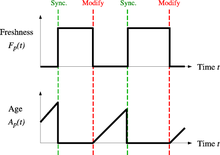
Two simple re-visiting policies were studied by Cho and Garcia-Molina:[31]
In both cases, the repeated crawling order of pages can be done either in a random or a fixed order.
Cho and Garcia-Molina proved the surprising result that, in terms of average freshness, the uniform policy outperforms the proportional policy in both a simulated Web and a real Web crawl. Intuitively, the reasoning is that, as web crawlers have a limit to how many pages they can crawl in a given time frame, (1) they will allocate too many new crawls to rapidly changing pages at the expense of less frequently updating pages, and (2) the freshness of rapidly changing pages lasts for shorter period than that of less frequently changing pages. In other words, a proportional policy allocates more resources to crawling frequently updating pages, but experiences less overall freshness time from them.
To improve freshness, the crawler should penalize the elements that change too often.[32] The optimal re-visiting policy is neither the uniform policy nor the proportional policy. The optimal method for keeping average freshness high includes ignoring the pages that change too often, and the optimal for keeping average age low is to use access frequencies that monotonically (and sub-linearly) increase with the rate of change of each page. In both cases, the optimal is closer to the uniform policy than to the proportional policy: as Coffman et al. note, "in order to minimize the expected obsolescence time, the accesses to any particular page should be kept as evenly spaced as possible".[30] Explicit formulas for the re-visit policy are not attainable in general, but they are obtained numerically, as they depend on the distribution of page changes. Cho and Garcia-Molina show that the exponential distribution is a good fit for describing page changes,[32] while Ipeirotis et al. show how to use statistical tools to discover parameters that affect this distribution.[33] The re-visiting policies considered here regard all pages as homogeneous in terms of quality ("all pages on the Web are worth the same"), something that is not a realistic scenario, so further information about the Web page quality should be included to achieve a better crawling policy.
Crawlers can retrieve data much quicker and in greater depth than human searchers, so they can have a crippling impact on the performance of a site. If a single crawler is performing multiple requests per second and/or downloading large files, a server can have a hard time keeping up with requests from multiple crawlers.
As noted by Koster, the use of Web crawlers is useful for a number of tasks, but comes with a price for the general community.[34] The costs of using Web crawlers include:
A partial solution to these problems is the robots exclusion protocol, also known as the robots.txt protocol that is a standard for administrators to indicate which parts of their Web servers should not be accessed by crawlers.[35] This standard does not include a suggestion for the interval of visits to the same server, even though this interval is the most effective way of avoiding server overload. Recently commercial search engines like Google, Ask Jeeves, MSN and Yahoo! Search are able to use an extra "Crawl-delay:" parameter in the robots.txt file to indicate the number of seconds to delay between requests.
The first proposed interval between successive pageloads was 60 seconds.[36] However, if pages were downloaded at this rate from a website with more than 100,000 pages over a perfect connection with zero latency and infinite bandwidth, it would take more than 2 months to download only that entire Web site; also, only a fraction of the resources from that Web server would be used.
Cho uses 10 seconds as an interval for accesses,[31] and the WIRE crawler uses 15 seconds as the default.[37] The MercatorWeb crawler follows an adaptive politeness policy: if it took t seconds to download a document from a given server, the crawler waits for 10t seconds before downloading the next page.[38] Dill et al. use 1 second.[39]
For those using Web crawlers for research purposes, a more detailed cost-benefit analysis is needed and ethical considerations should be taken into account when deciding where to crawl and how fast to crawl.[40]
Anecdotal evidence from access logs shows that access intervals from known crawlers vary between 20 seconds and 3–4 minutes. It is worth noticing that even when being very polite, and taking all the safeguards to avoid overloading Web servers, some complaints from Web server administrators are received. Sergey Brin and Larry Page noted in 1998, "... running a crawler which connects to more than half a million servers ... generates a fair amount of e-mail and phone calls. Because of the vast number of people coming on line, there are always those who do not know what a crawler is, because this is the first one they have seen."[41]
A parallel crawler is a crawler that runs multiple processes in parallel. The goal is to maximize the download rate while minimizing the overhead from parallelization and to avoid repeated downloads of the same page. To avoid downloading the same page more than once, the crawling system requires a policy for assigning the new URLs discovered during the crawling process, as the same URL can be found by two different crawling processes.

A crawler must not only have a good crawling strategy, as noted in the previous sections, but it should also have a highly optimized architecture.
Shkapenyuk and Suel noted that:[42]
While it is fairly easy to build a slow crawler that downloads a few pages per second for a short period of time, building a high-performance system that can download hundreds of millions of pages over several weeks presents a number of challenges in system design, I/O and network efficiency, and robustness and manageability.
Web crawlers are a central part of search engines, and details on their algorithms and architecture are kept as business secrets. When crawler designs are published, there is often an important lack of detail that prevents others from reproducing the work. There are also emerging concerns about "search engine spamming", which prevent major search engines from publishing their ranking algorithms.
While most of the website owners are keen to have their pages indexed as broadly as possible to have strong presence in search engines, web crawling can also have unintended consequences and lead to a compromise or data breach if a search engine indexes resources that should not be publicly available, or pages revealing potentially vulnerable versions of software.
Apart from standard web application security recommendations website owners can reduce their exposure to opportunistic hacking by only allowing search engines to index the public parts of their websites (with robots.txt) and explicitly blocking them from indexing transactional parts (login pages, private pages, etc.).
Web crawlers typically identify themselves to a Web server by using the User-agent field of an HTTP request. Web site administrators typically examine their Web servers' log and use the user agent field to determine which crawlers have visited the web server and how often. The user agent field may include a URL where the Web site administrator may find out more information about the crawler. Examining Web server log is tedious task, and therefore some administrators use tools to identify, track and verify Web crawlers. Spambots and other malicious Web crawlers are unlikely to place identifying information in the user agent field, or they may mask their identity as a browser or other well-known crawler.
Web site administrators prefer Web crawlers to identify themselves so that they can contact the owner if needed. In some cases, crawlers may be accidentally trapped in a crawler trap or they may be overloading a Web server with requests, and the owner needs to stop the crawler. Identification is also useful for administrators that are interested in knowing when they may expect their Web pages to be indexed by a particular search engine.
A vast amount of web pages lie in the deep or invisible web.[43] These pages are typically only accessible by submitting queries to a database, and regular crawlers are unable to find these pages if there are no links that point to them. Google's Sitemaps protocol and mod oai[44] are intended to allow discovery of these deep-Web resources.
Deep web crawling also multiplies the number of web links to be crawled. Some crawlers only take some of the URLs in <a href="URL"> form. In some cases, such as the Googlebot, Web crawling is done on all text contained inside the hypertext content, tags, or text.
Strategic approaches may be taken to target deep Web content. With a technique called screen scraping, specialized software may be customized to automatically and repeatedly query a given Web form with the intention of aggregating the resulting data. Such software can be used to span multiple Web forms across multiple Websites. Data extracted from the results of one Web form submission can be taken and applied as input to another Web form thus establishing continuity across the Deep Web in a way not possible with traditional web crawlers.[45]
Pages built on AJAX are among those causing problems to web crawlers. Google has proposed a format of AJAX calls that their bot can recognize and index.[46]
There are a number of "visual web scraper/crawler" products available on the web which will crawl pages and structure data into columns and rows based on the users requirements. One of the main difference between a classic and a visual crawler is the level of programming ability required to set up a crawler. The latest generation of "visual scrapers" remove the majority of the programming skill needed to be able to program and start a crawl to scrape web data.
The visual scraping/crawling method relies on the user "teaching" a piece of crawler technology, which then follows patterns in semi-structured data sources. The dominant method for teaching a visual crawler is by highlighting data in a browser and training columns and rows. While the technology is not new, for example it was the basis of Needlebase which has been bought by Google (as part of a larger acquisition of ITA Labs[47]), there is continued growth and investment in this area by investors and end-users.[citation needed]
The following is a list of published crawler architectures for general-purpose crawlers (excluding focused web crawlers), with a brief description that includes the names given to the different components and outstanding features:
The following web crawlers are available, for a price::
cite book: CS1 maint: multiple names: authors list (link)cite journal: Cite journal requires |journal= (help)cite journal: Cite journal requires |journal= (help)
Search engine optimisation consultants analyze your website and its performance, identify issues, and recommend strategies to improve your search rankings. They provide guidance on keyword selection, on-page optimization, link building, and content strategy to increase visibility and attract more traffic.
Local SEO services in Sydney focus on optimizing a business's online presence to attract local customers. This includes claiming local business listings, optimizing Google My Business profiles, using location-specific keywords, and ensuring consistent NAP (Name, Address, Phone) information across the web.
SEO agencies in Sydney typically offer comprehensive services such as keyword research, technical audits, on-page and off-page optimization, content creation, and performance tracking. Their goal is to increase your site's search engine rankings and drive more targeted traffic to your website.
A local SEO agency specializes in improving a business's visibility within a specific geographic area. They focus on optimizing local citations, managing Google My Business profiles, and targeting location-based keywords to attract nearby customers.
SEO packages in Australia typically bundle essential optimization services such as keyword research, technical audits, content creation, and link building at a set price. They are designed to simplify the process, provide consistent results, and help businesses of all sizes improve their online visibility.